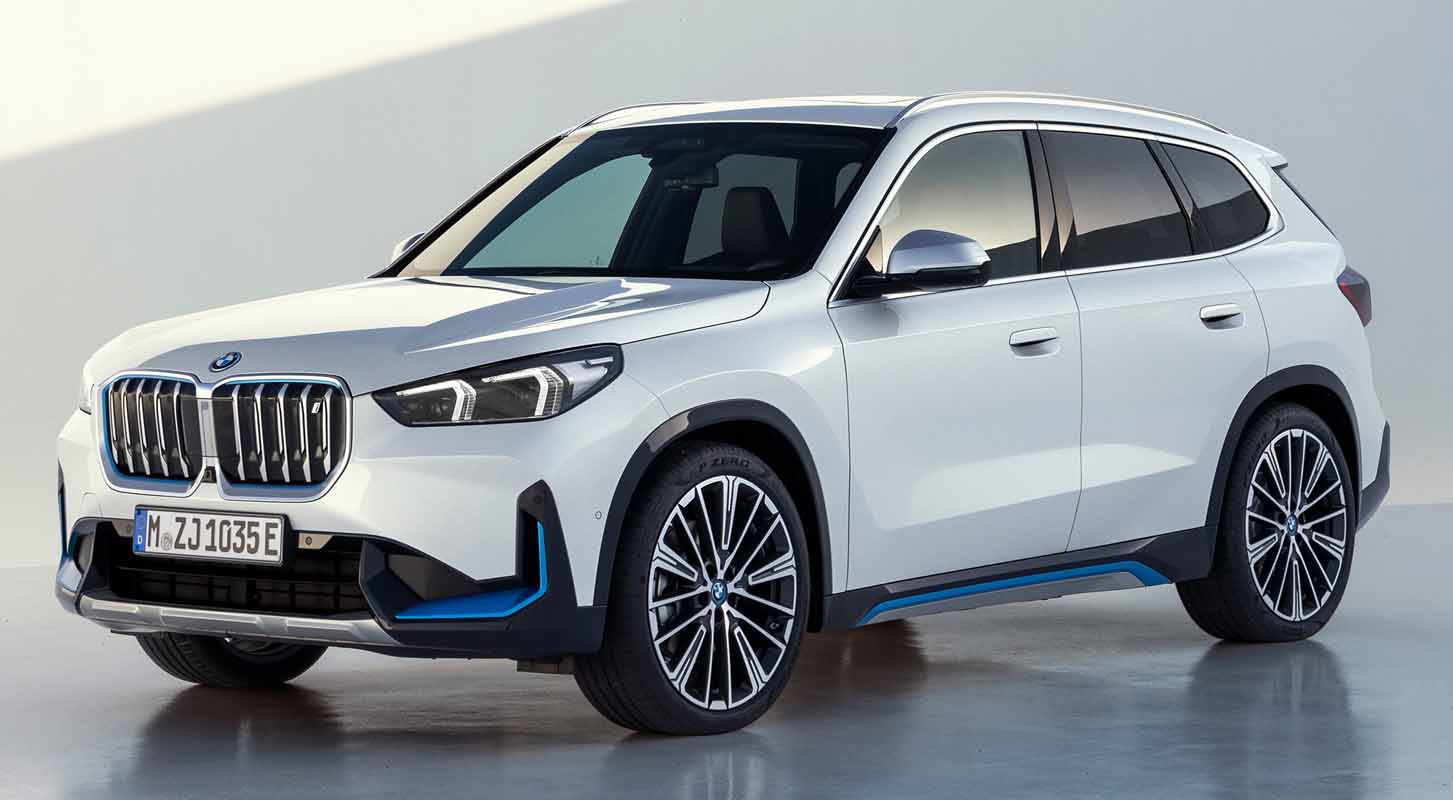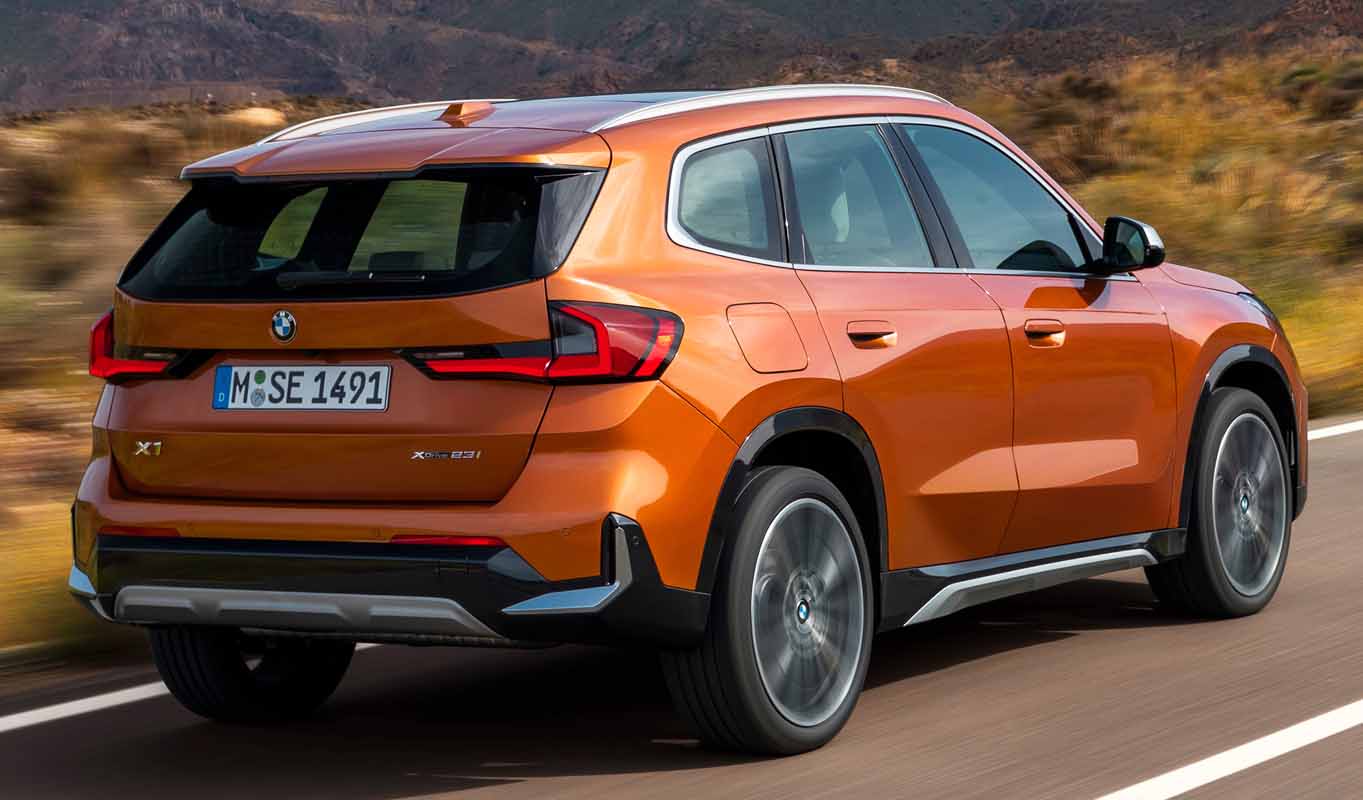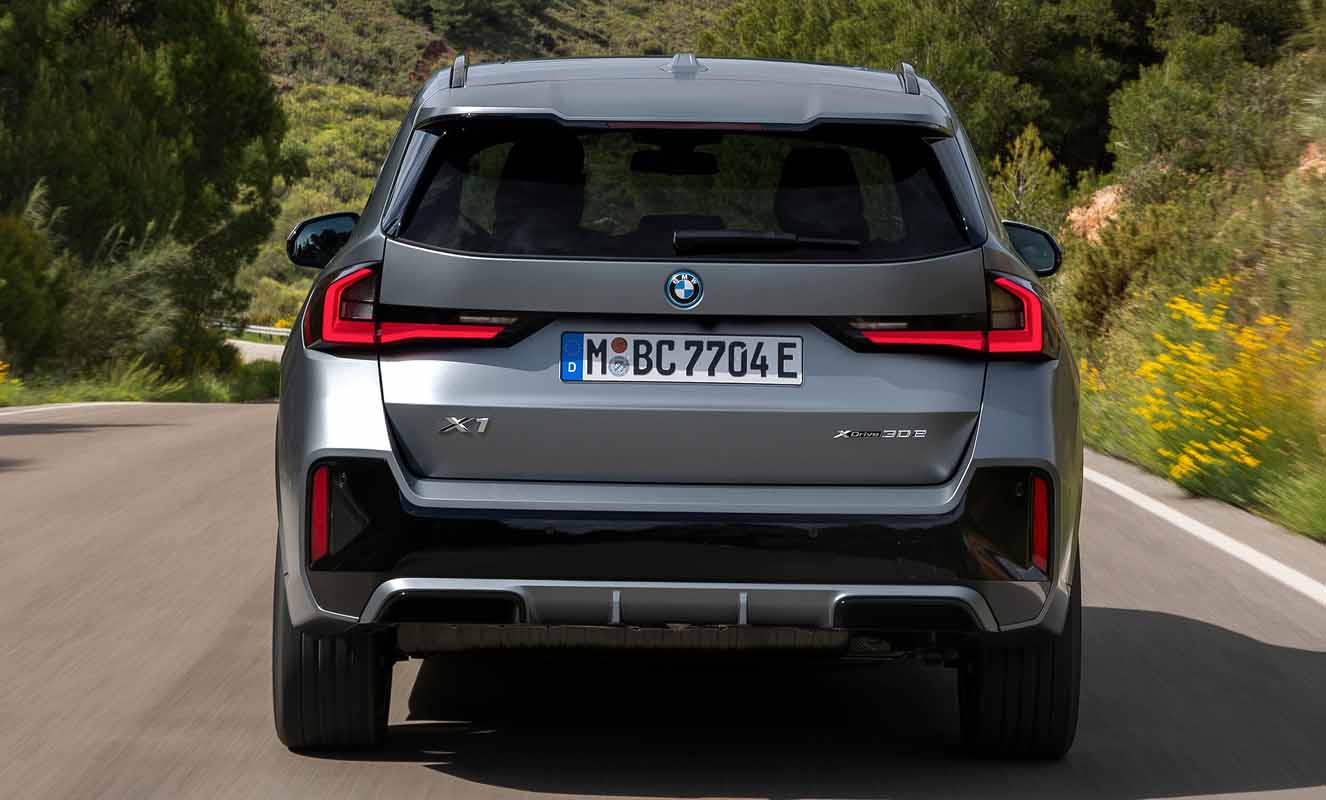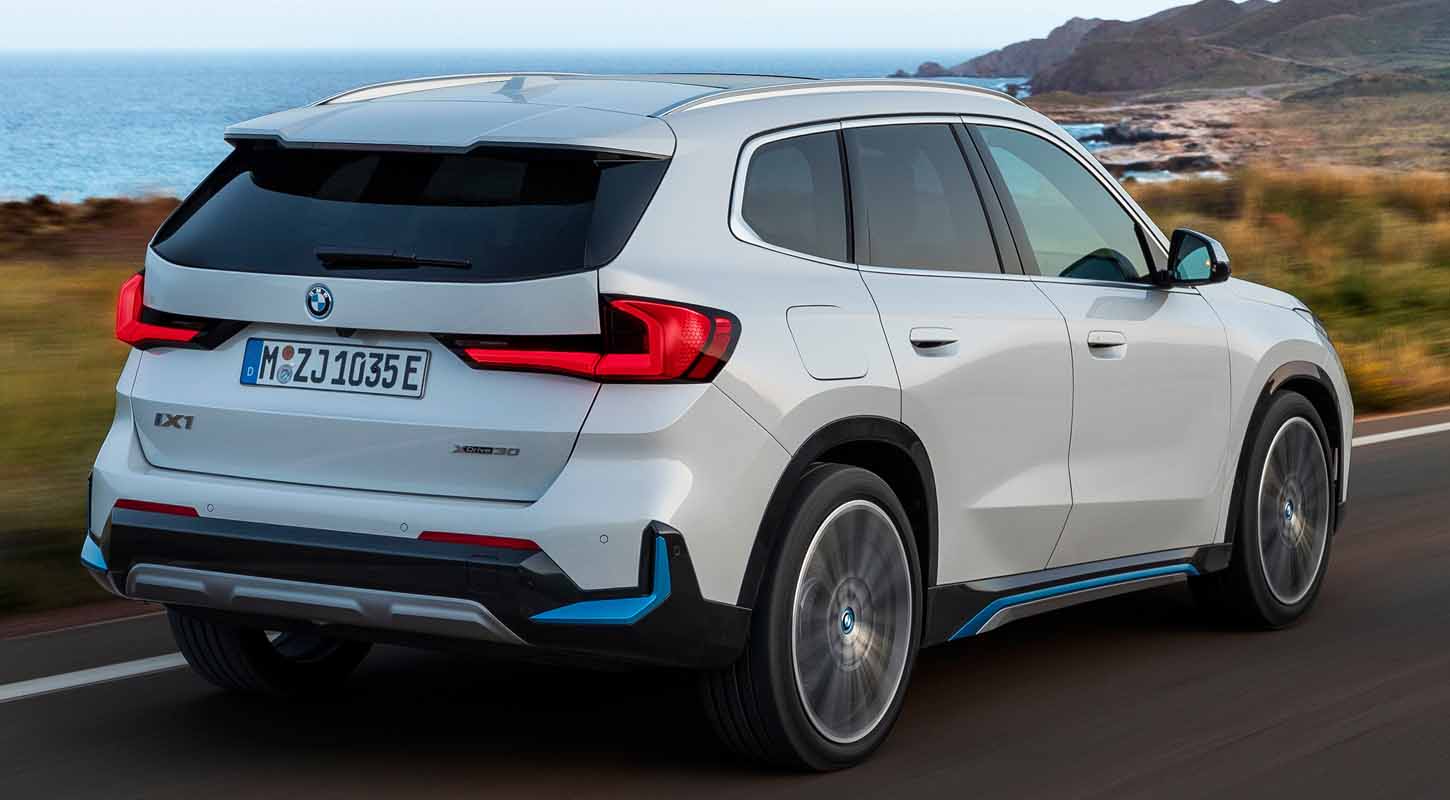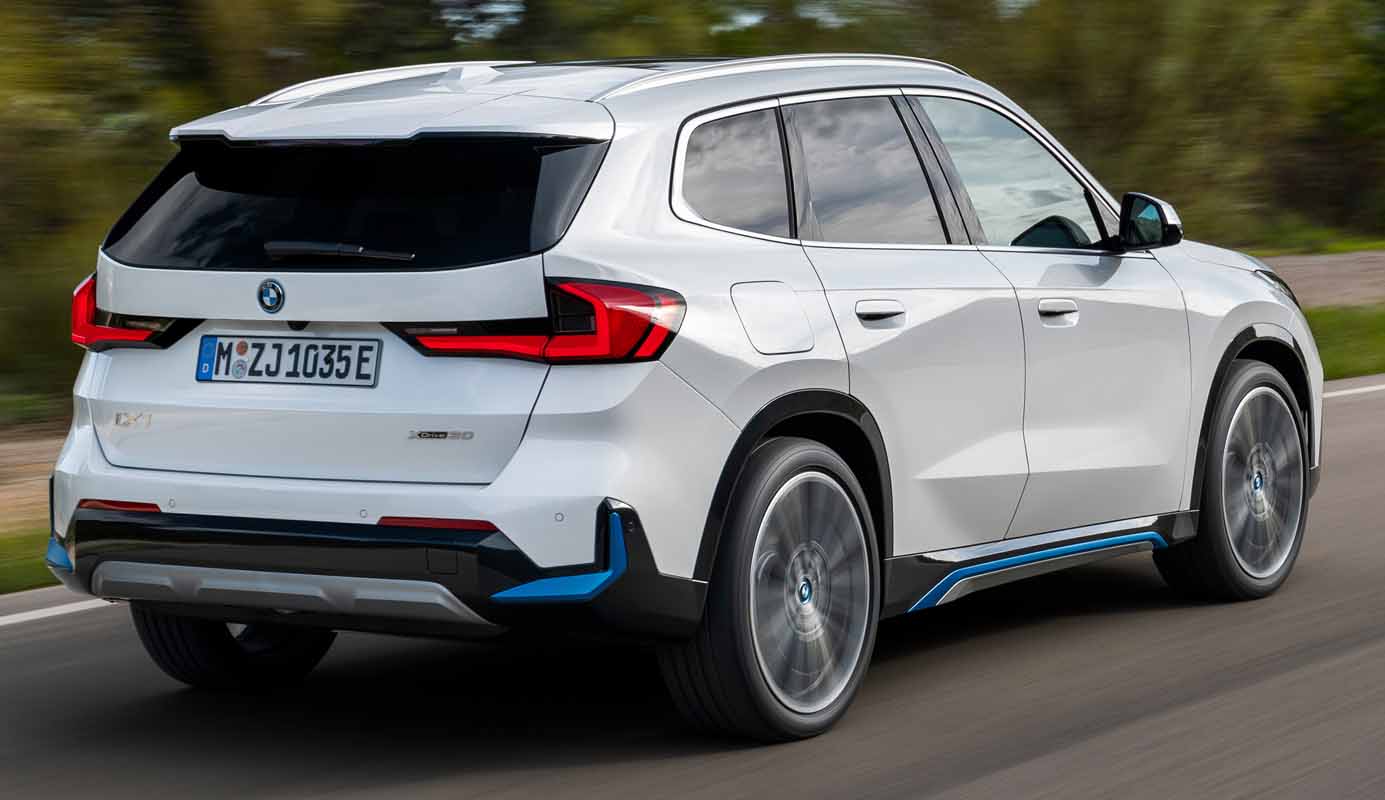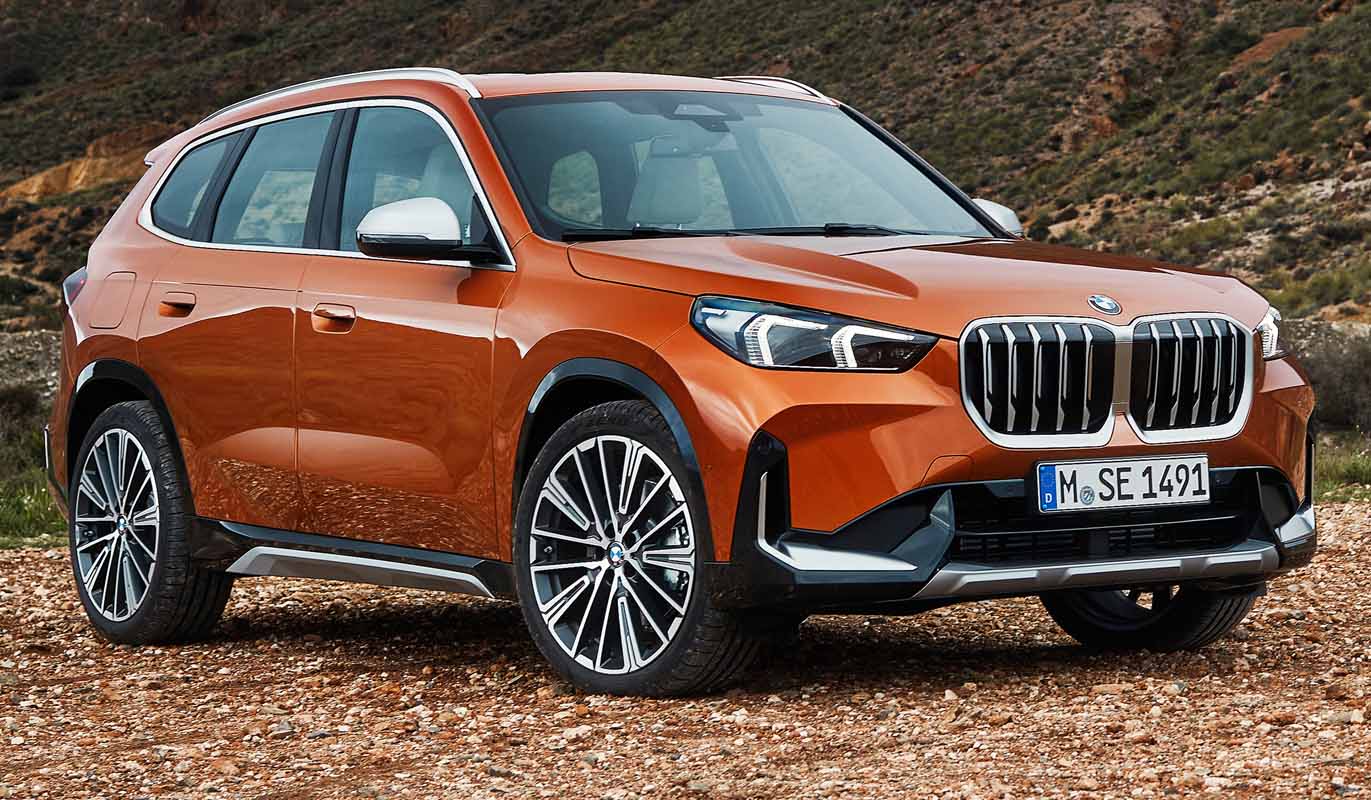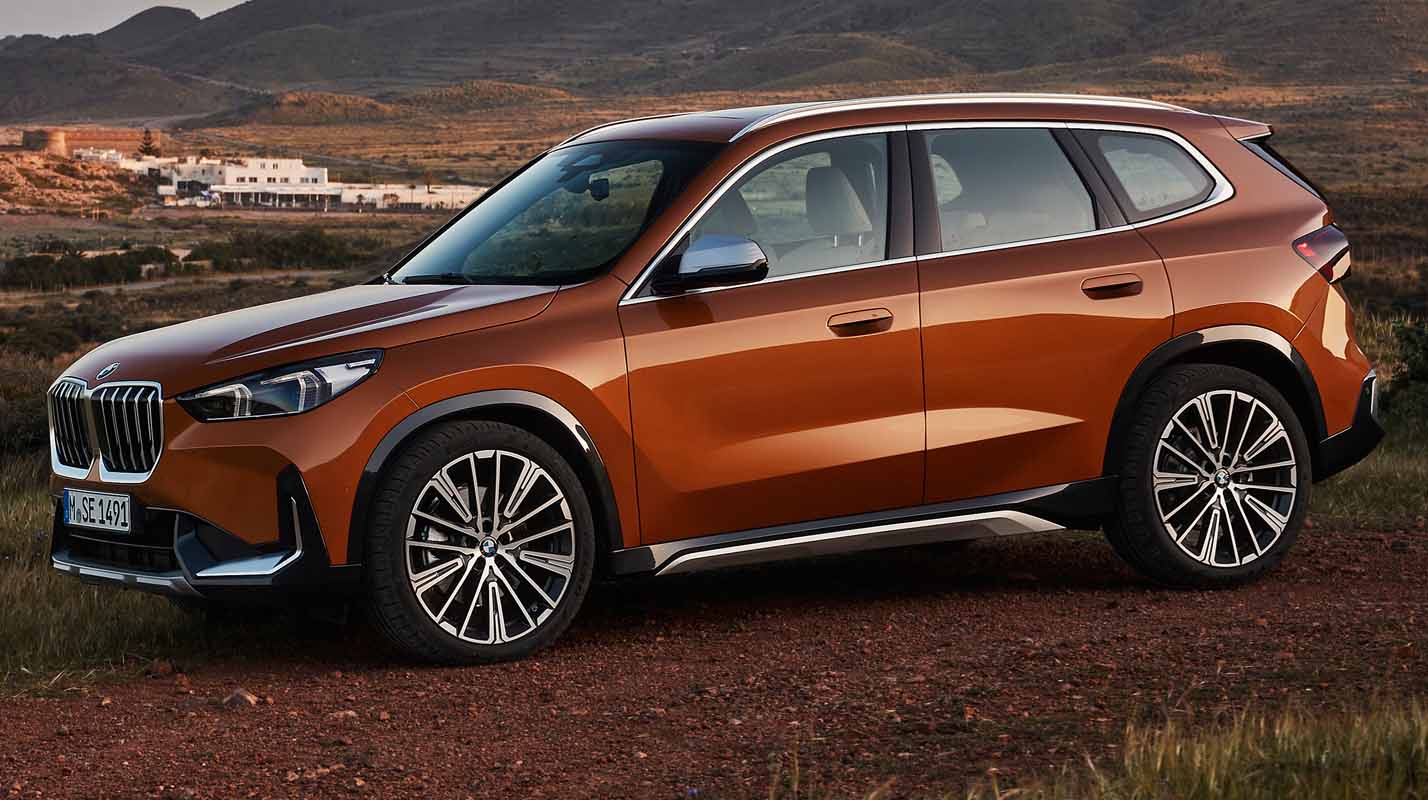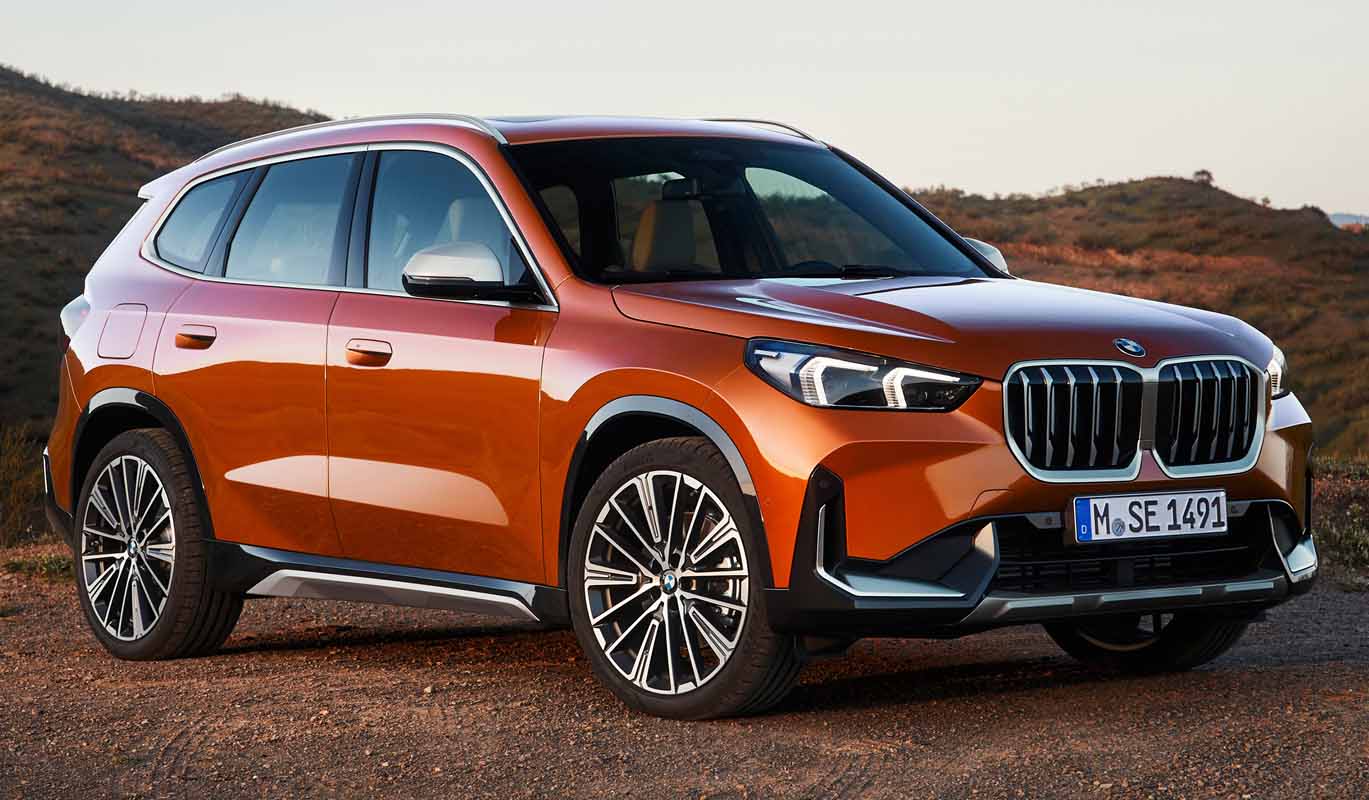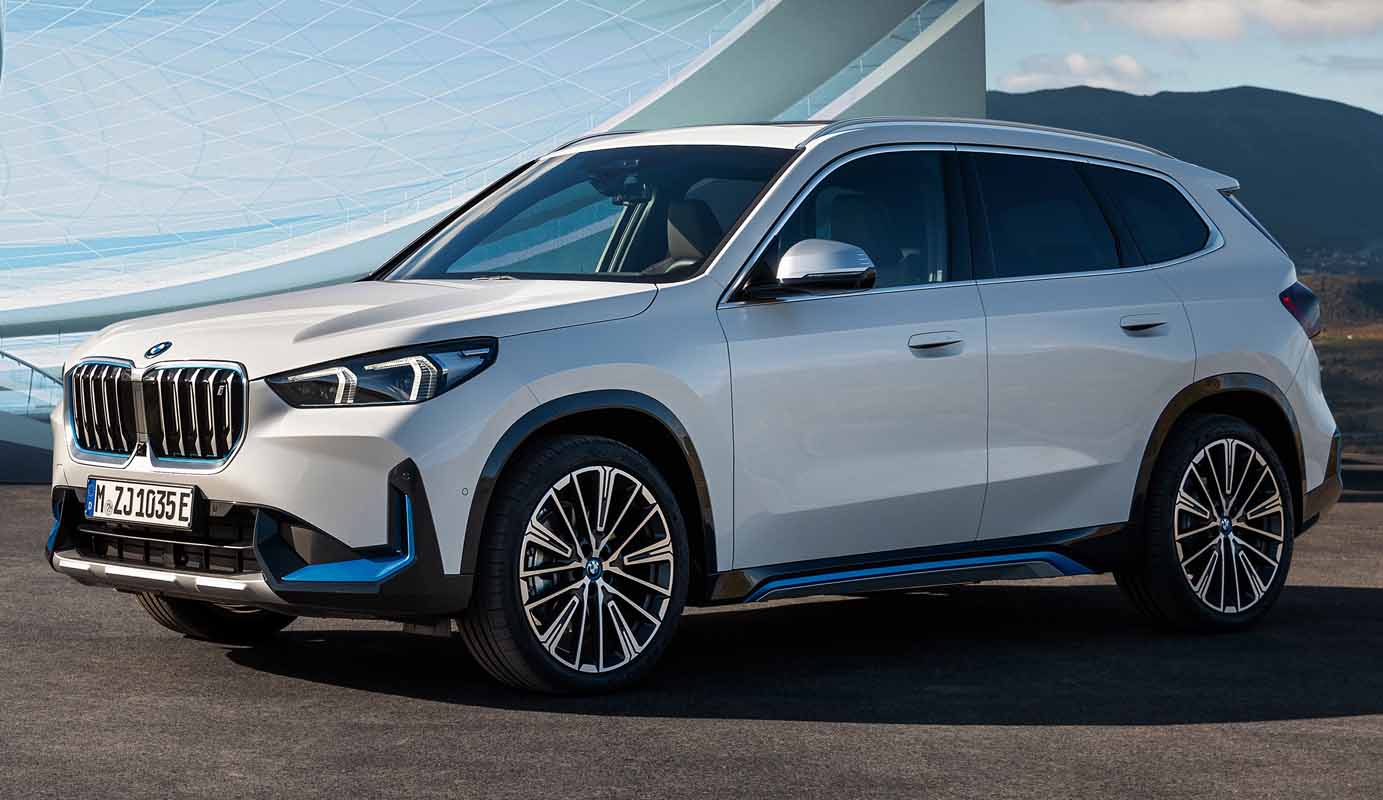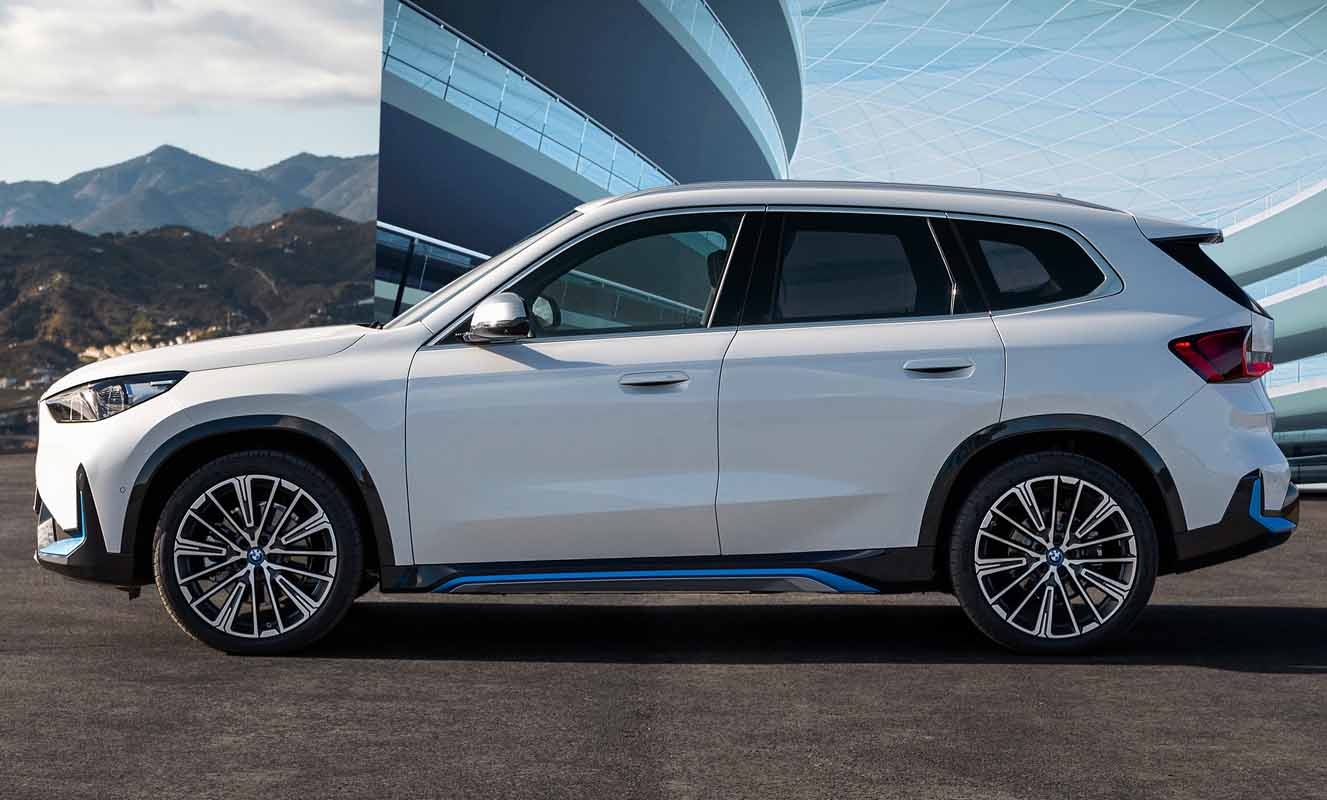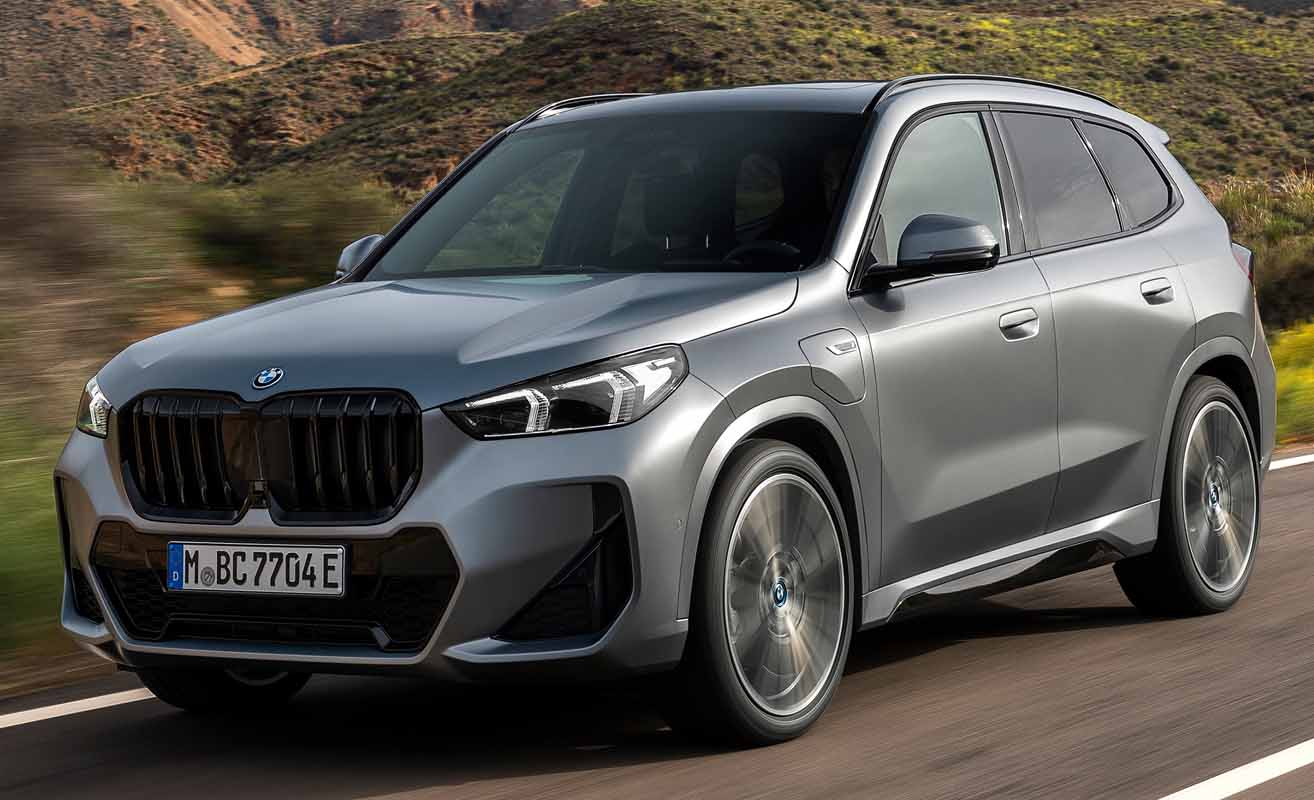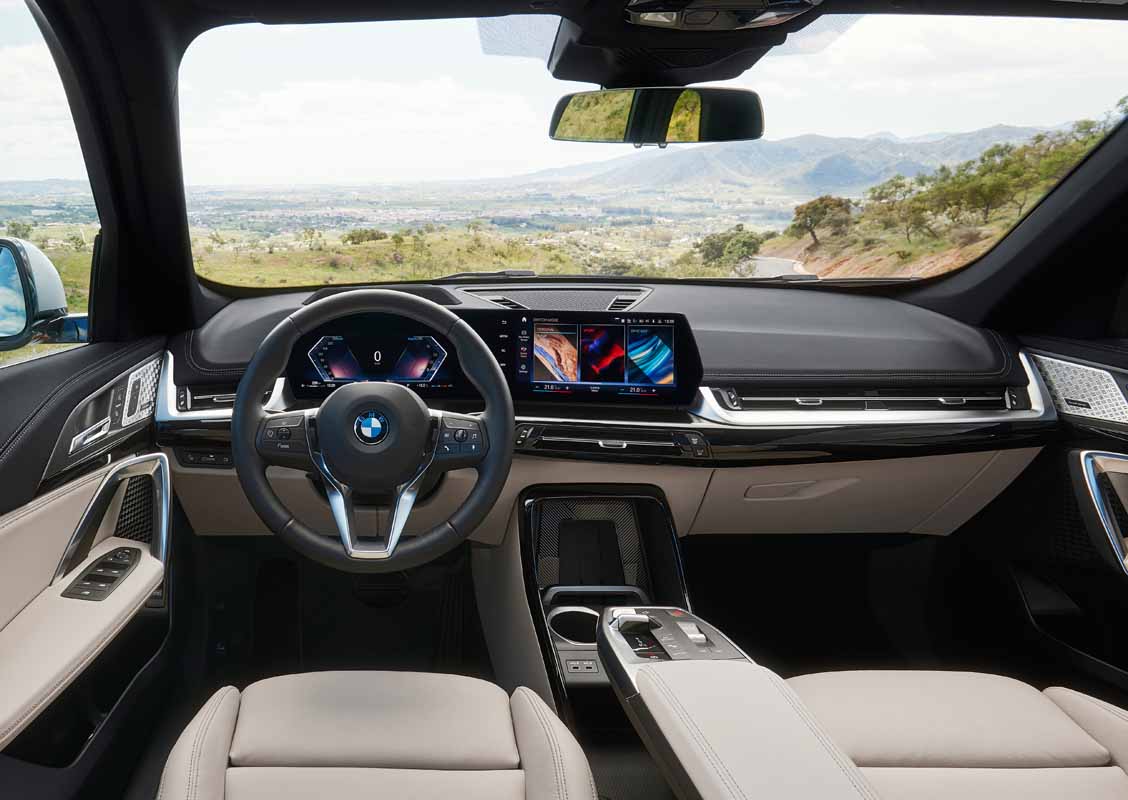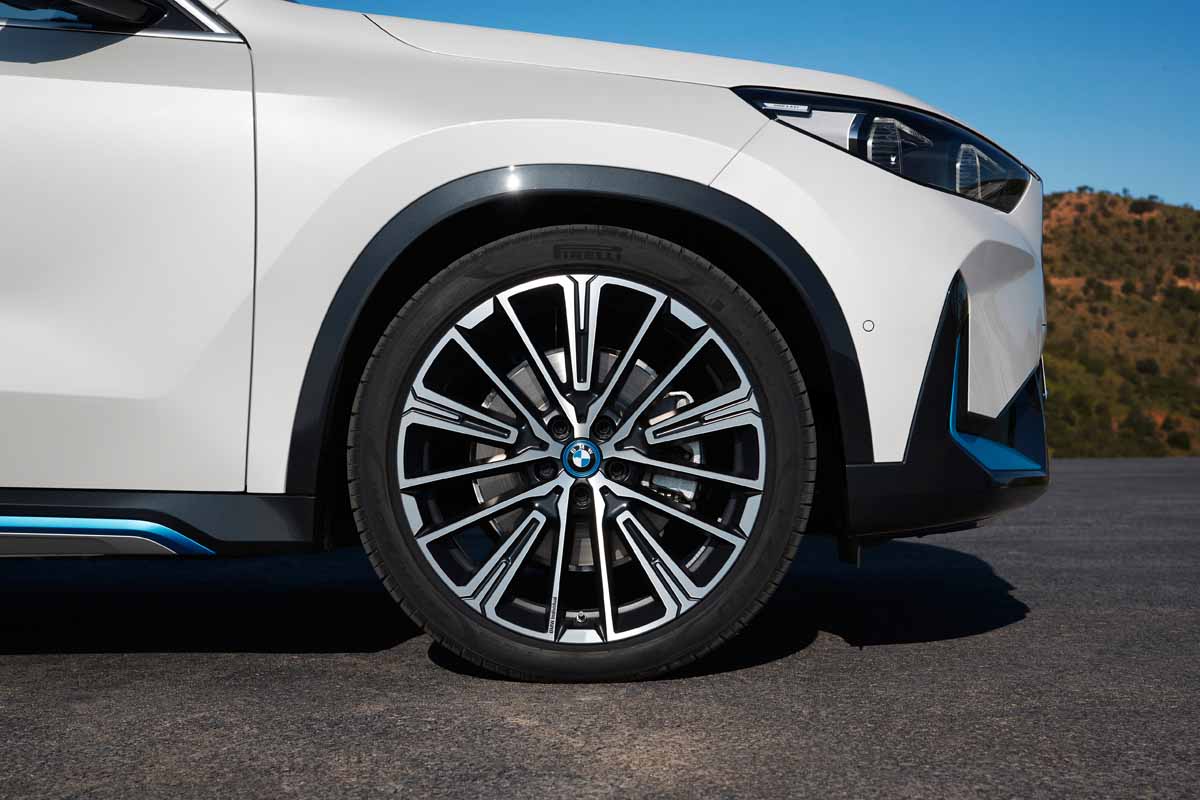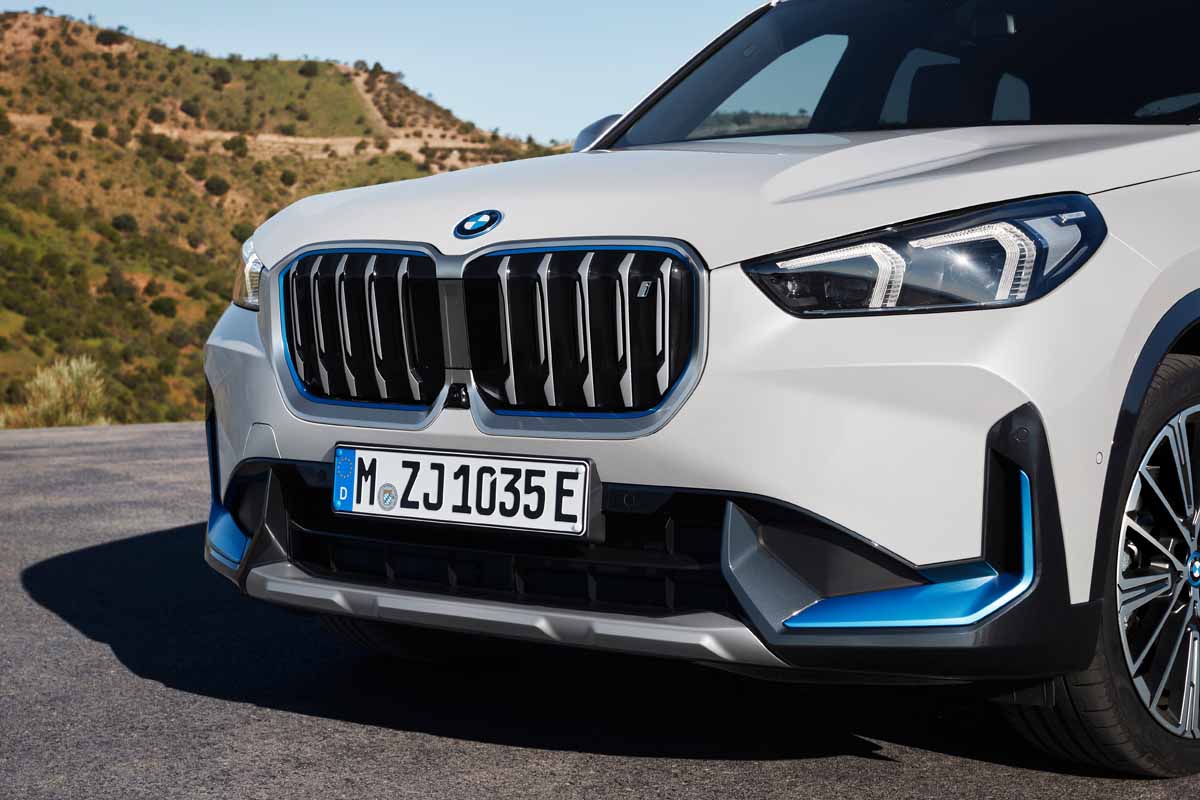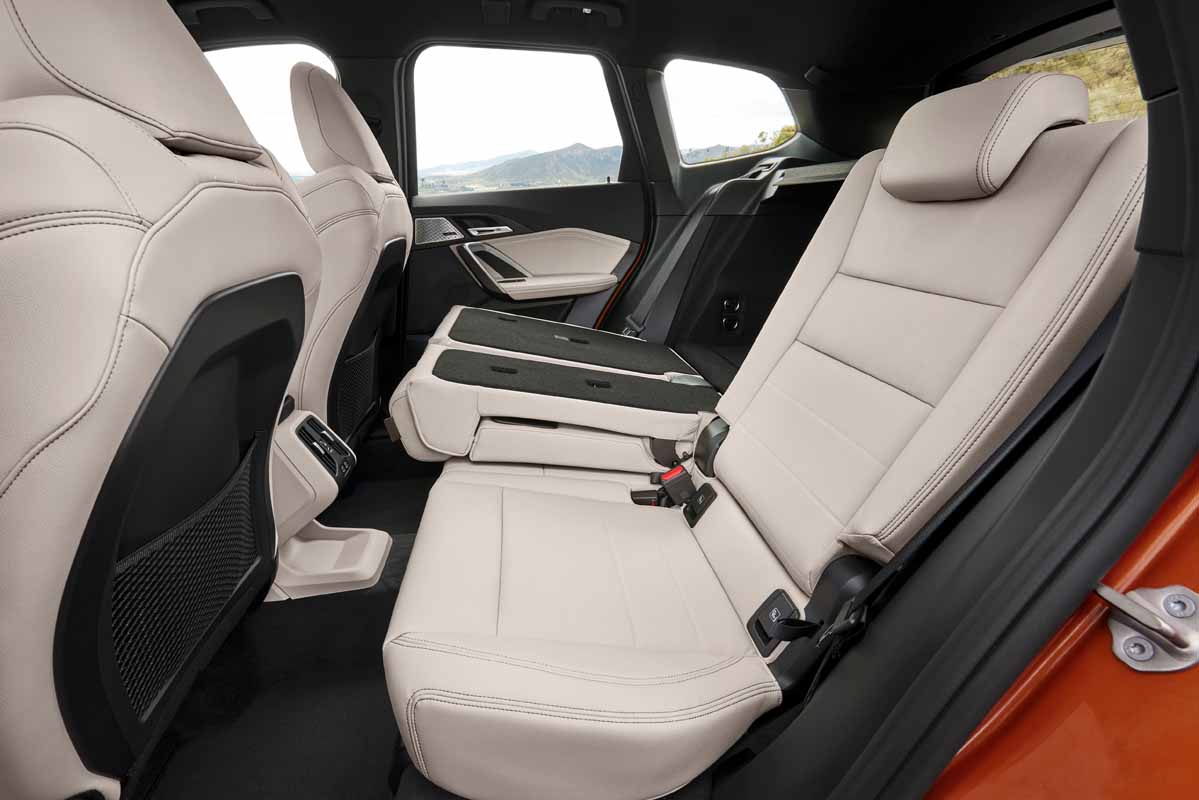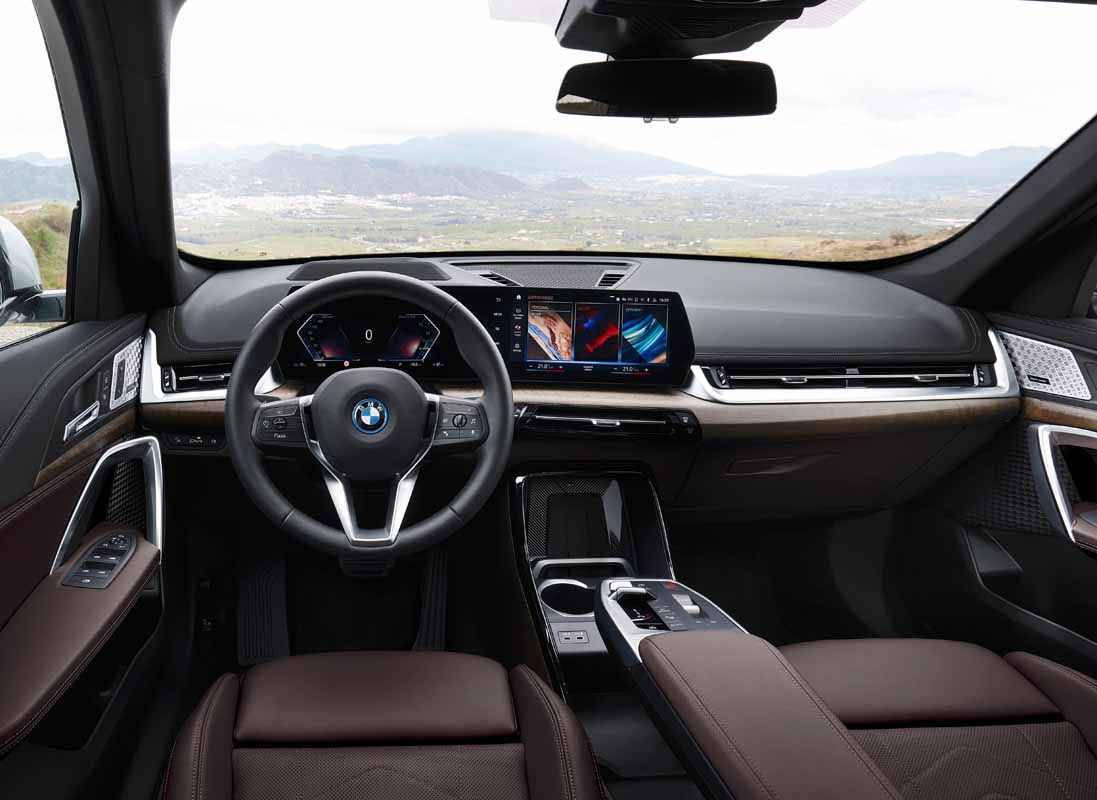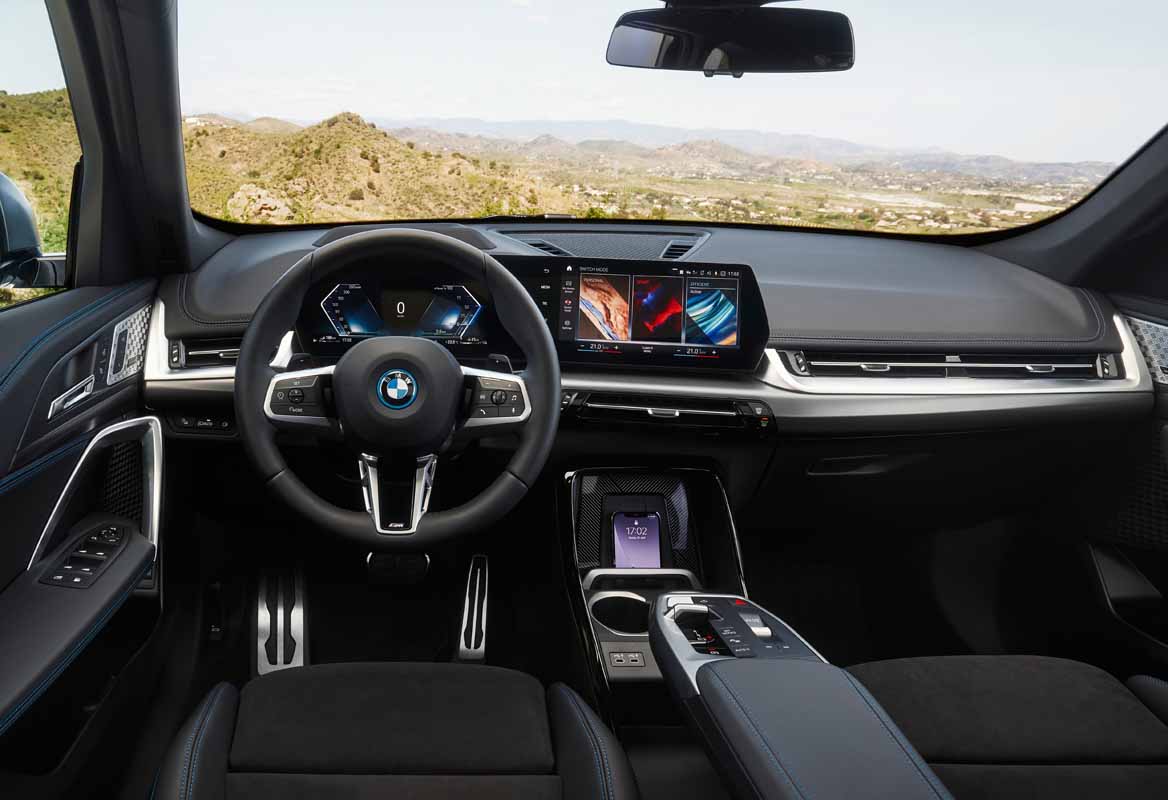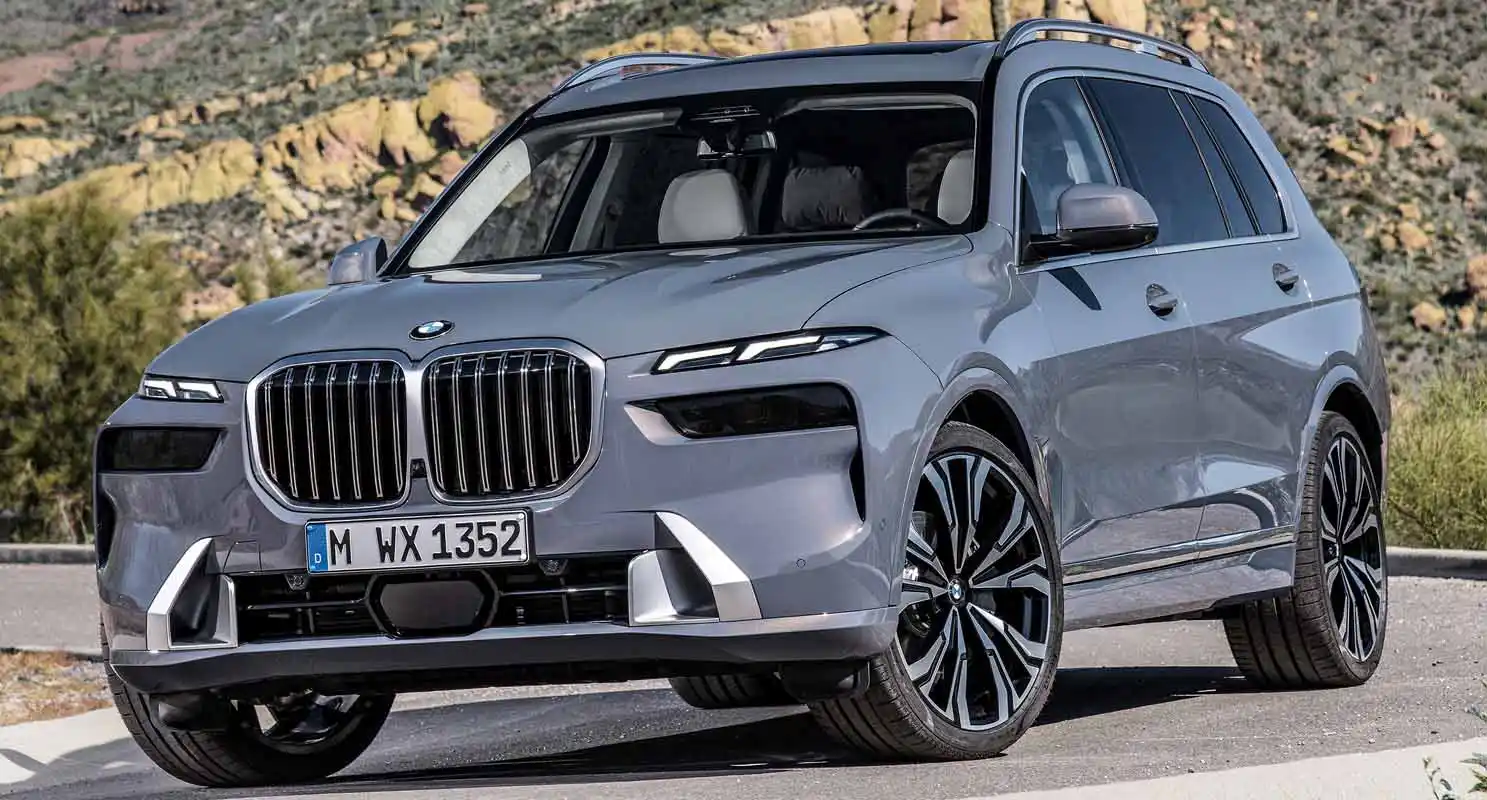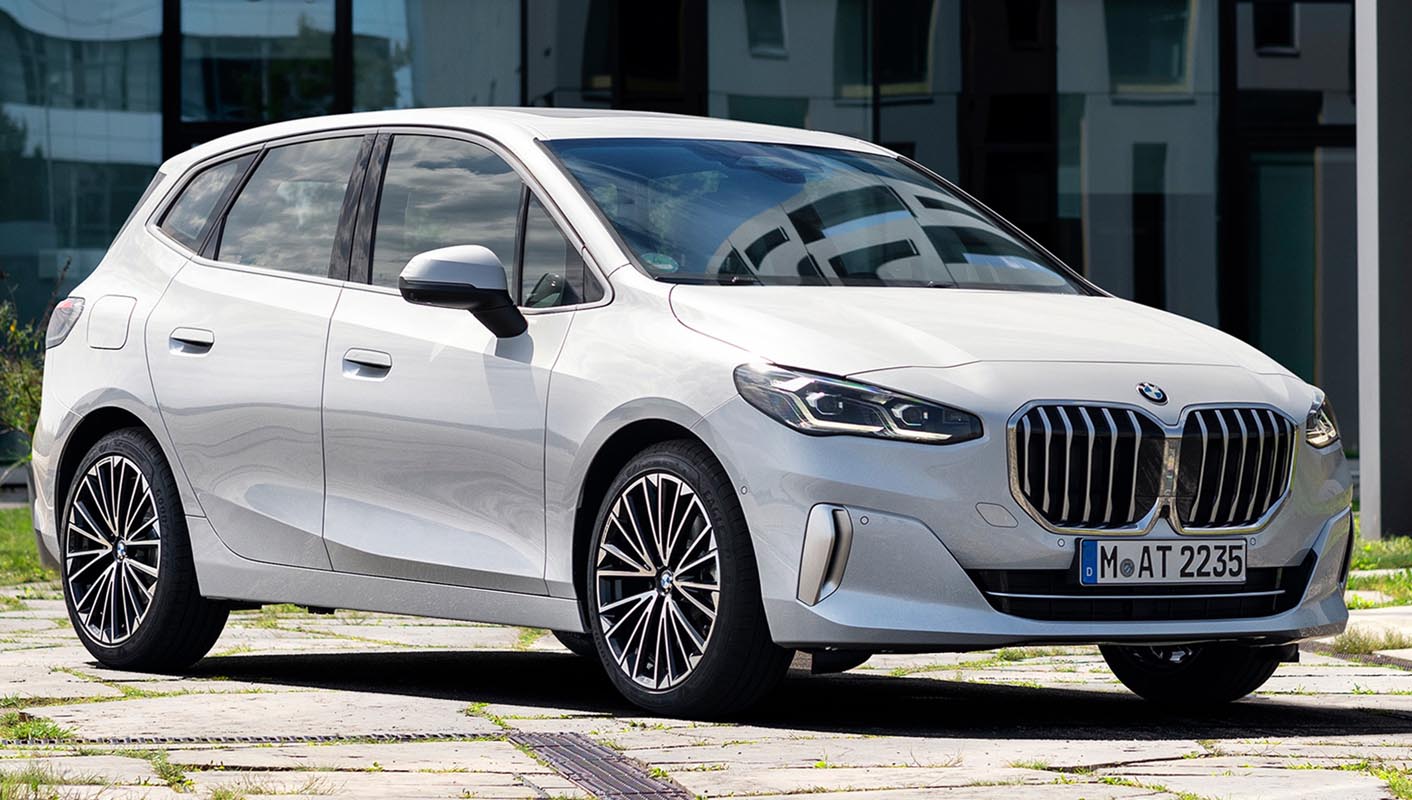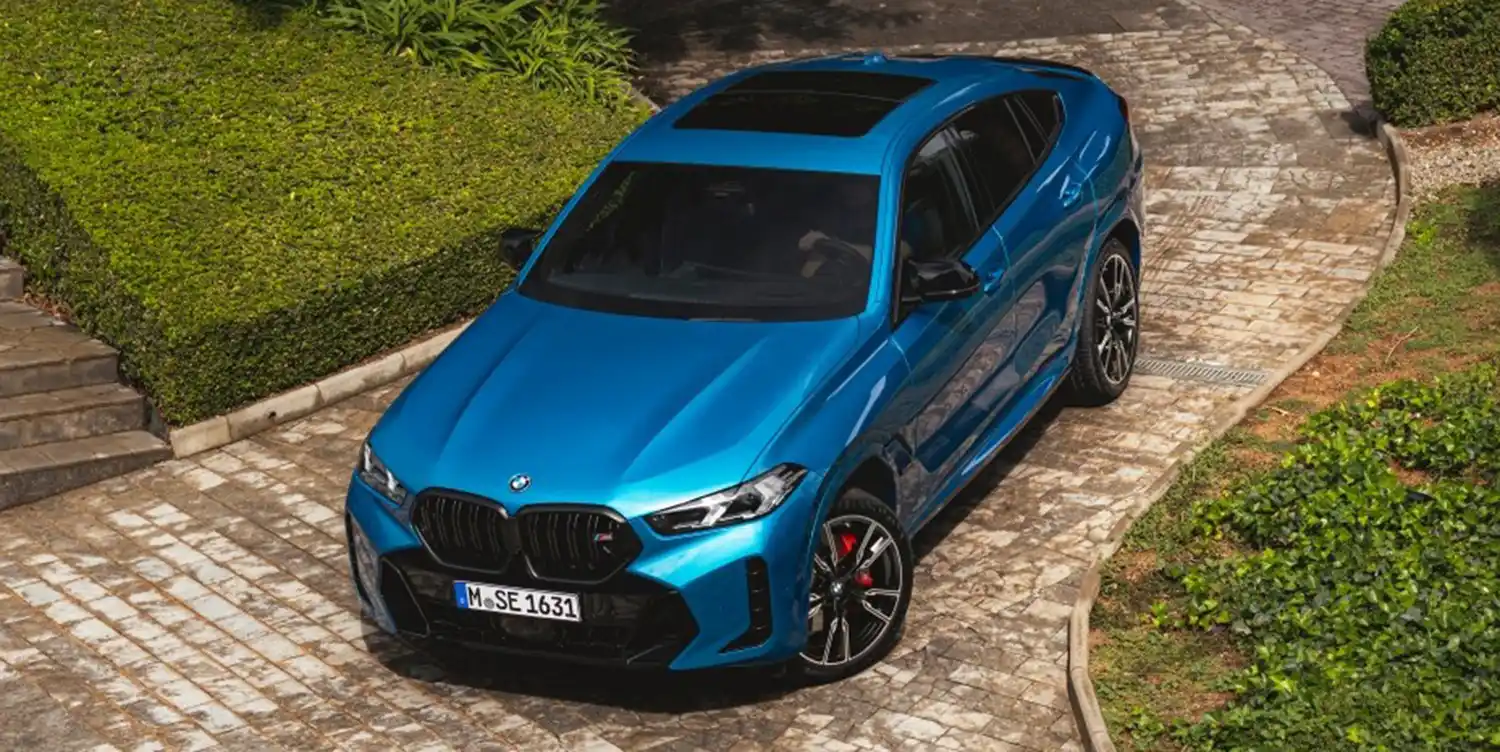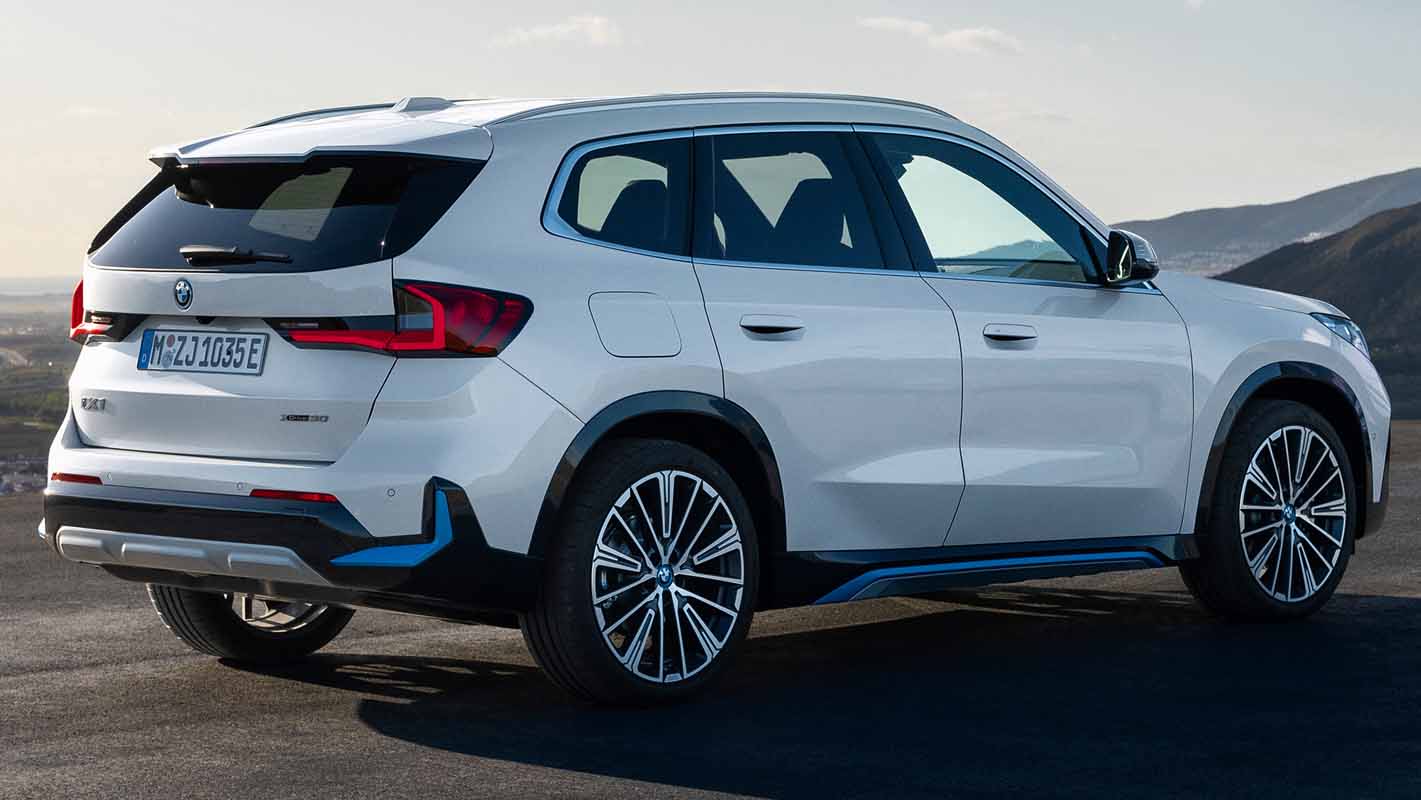
Instantly accessible driving pleasure and modern versatility mark out the character of the new BMW X1. With its more prominent design, commitment to electrification and progressive connectivity, the X1 leads the successful vehicle concept of a Sports Activity Vehicle (SAV) for the premium compact segment into a future shaped by sustainability and digitalisation. Significantly expanded standard specification, increased spaciousness and a premium ambience for the interior, the new control/operation system with BMW Operating System 8 and the BMW Curved Display, and a large selection of systems for automated driving and parking underscore the standout status of the new BMW X1 against its rivals.
When the original BMW X1 was launched in 2009, it opened up a new vehicle category in the premium segment. Since then, the compact SAV has served as an attractive entry model into the world of BMW X. With its robust character profile and functional versatility, the BMW X1 embodies an authentic experience of freedom and independence in day-to-day driving and on longer journeys. Its strong popularity is reflected in the total of around 1.9 million units sold so far in markets around the world.
Substantial boost for the accelerated ramp-up of electric mobility
In its third model generation, the BMW X1 also offers a gateway to BMW i-style electric mobility for a wide target audience. The BMW iX1 xDrive30 (electric power consumption, combined in the WLTP cycle: 18.4 – 17.3 kWh/100 km; CO2 emissions: 0 g/km) due to go on sale immediately after the launch of the new model generation is the BMW Group’s first premium compact model based on a flexible vehicle architecture to feature an all-electric drive system. The company’s offering accelerates the ramp-up of electric mobility, which is one of its strategic points of focus. The BMW Group is aiming to have more than two million fully electric vehicles on the road by the end of 2025. Indeed, by 2030 every other vehicle sold by the BMW Group worldwide should have an all-electric drive system.
The market launch of the new BMW X1 will get underway in October 2022 with two petrol-engined variants and two diesels initially available.
Another petrol model and one more diesel will follow immediately afterwards, joined by the BMW iX1 xDrive30 and a pair of plug-in hybrid models.
All new BMW X1 models will be built at BMW Group Plant Regensburg, which also hosted production of the outgoing model generation – plug-in hybrid variant included. Models with combustion engines, plug-in hybrid systems and all-electric drive will now roll off a single assembly line here. This ensures the plant will be able to respond flexibly to changes in customer demand as and when they occur. The high-voltage batteries for the BMW iX1 xDrive30 will likewise be produced at Regensburg. The high-voltage batteries fitted in the plug-in hybrid models and all other elements of fifth-generation BMW eDrive technology will be manufactured at BMW Group Plant Dingolfing, the company’s centre of excellence for the production of e-drive components.
Preparations for the new model generation at BMW Group Plant Regensburg included putting in place new conveyor and assembly systems for the high-voltage batteries. In addition, internal logistics have been optimised using state-of-the-art digitalisation. In the bodyshop at Regensburg, the new model has been integrated into the manufacturing process during ongoing series production. And the plant’s paintshop uses the Integrated Painting Process (IPP), which increases the efficiency of the coating application process for the body at the same time as reducing energy consumption.
Robust exterior, spacious interior
With its significantly sharper design and increased interior space, the new BMW X1 represents an immediately recognisable leap forward in development. As a result, the new edition underlines its status as a member of the BMW X model family more clearly than ever. Key ingredients here include a clean and reduced surface design and Xtypical black borders at the lower edge of the body which accentuate the vehicle’s rugged character. Plus, the upright front end increases the visual presence of the new X1.
Moving inside, the new BMW X1 has five full-size seats and its loadcarrying capacity can be utilised in a wide variety of ways. The driver and front passenger benefit in particular from the noticeable increase in shoulder and elbow room. The rear seat backrests can fold down in a 40 : 20 : 40 split as standard, and their angle can also be adjusted as an option to further increase seating comfort. Added to which, the purely combustion-engined models can be specified as an option with a rear seat bench that slides fore and aft, allowing either legroom for the rear seats or the amount of boot space to be increased. With all the seats in use, the new BMW X1 has a load capacity of 540 litres, 35 litres more than its predecessor. This can be expanded to a maximum 1,600 litres (+50 litres).
The new BMW X1 has grown in its exterior dimensions compared to its predecessor – by 53 millimetres in length to 4,500 millimetres, 24 millimetres in width to 1,845 millimetres and 44 millimetres in to 1,642 millimetres, giving it powerful proportions. The new car has a wheelbase of 2,692 millimetres, 22 millimetres longer than that of its predecessor. Track widths have increased by 31 millimetres to 1,592 millimetres at the front axle and 1,593 millimetres at the rear axle, which enhances the handling composure and agility of the new BMW X1.
BMW Efficient Dynamics: Holistic concept for sustainability
Back in 2007, the BMW Group introduced a concept that remains unique in the automotive industry to this day. The Efficient Dynamics package of technology combined the unstinting reduction of fuel consumption and CO2 emissions with a commitment to increasing driving pleasure. Under BMW Efficient Dynamics, every aspect of vehicle development without exception is assessed by how it could help to optimise sustainability. As well as the powertrain, this applied primarily to energy management, aerodynamics and weight reduction through intelligent lightweight design.
These efficiency measures add to the appeal of the model range in terms of cost effectiveness and driving pleasure, giving BMW models a particularly future-focused premium character which sets them apart clearly from their rivals.
Intelligent lightweight design enhances agility and efficiency
The weight-optimised construction of the body and the chassis components helps to give the new BMW X1 its agility and efficiency. An intelligent mix of materials succeeds in minimising vehicle weight while also enhancing the body’s rigidity and crash safety. The hot-stamped steels and aluminium alloys used for the safety passenger cell are supplemented by multi-phase steels for extra reinforcement. In the front end of the BMW iX1 and plug-in hybrid models, an additional shear panel and a stiff connection with the high-voltage battery’s housing, which is designed as a load-bearing component, increase body rigidity. In addition, the all-electric model has a special driving dynamics strut, which connects the individual spring strut towers with one another. The increase in torsional rigidity achieved in this way enhances directional stability and sharpens turn-in response through corners.
Making the bonnet from aluminium cuts weight at the front end of the car, which gives handling agility another boost. Meanwhile, lightweight plastic supports for the front and rear doors bring further weight savings. Lightweight forged wheels (not fitted on all model variants) help reduce unsprung mass. And the use of steel components with a zinc/magnesium coating optimises corrosion protection.
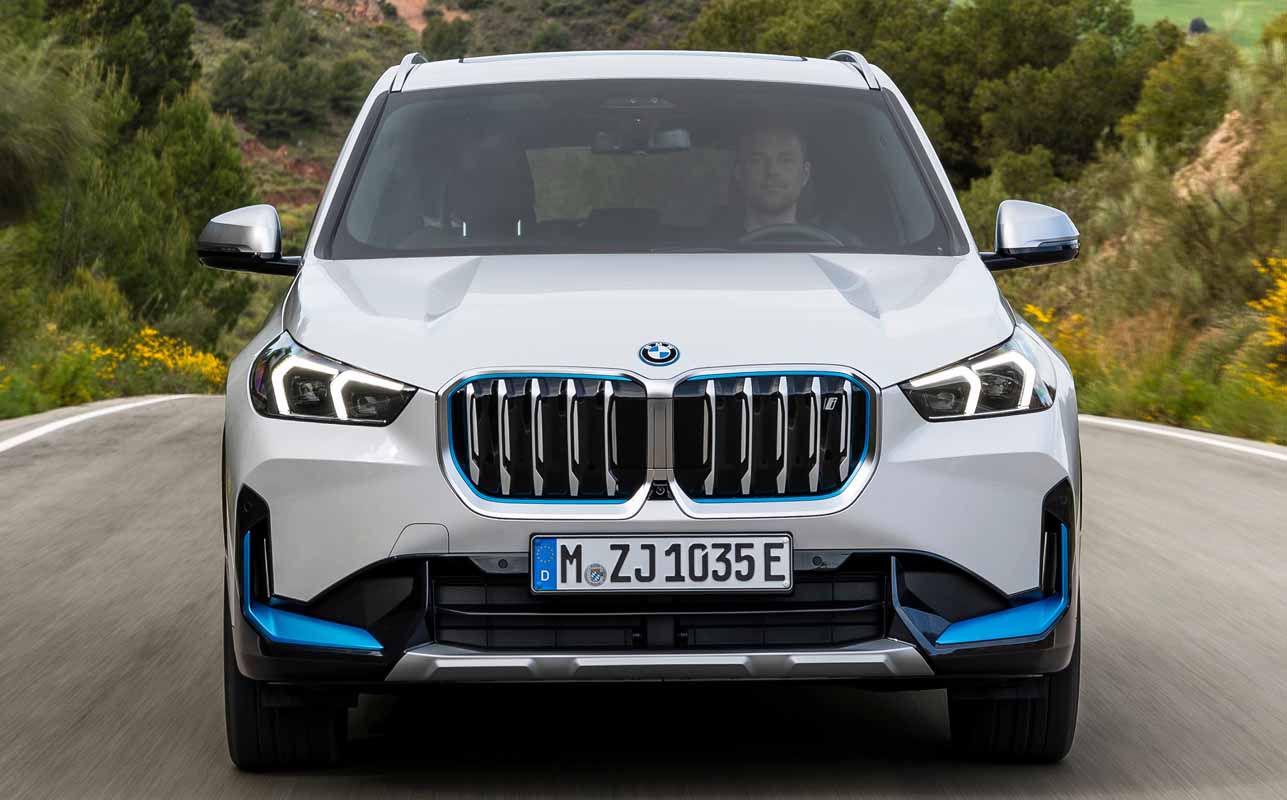
Integrated overall concept maximises occupant protection
A comprehensive passive safety concept maximises occupant protection in an extremely wide range of collisions and factors in the requirements of crash testing procedures in the markets where the new BMW X1 will be offered. Besides the extremely rigid passenger cell and highly resilient load-bearing structures, it also includes integrated safety electronics which deploy the restraint systems in the right sequence, at the optimum moment and with the required effect for the specific collision type and severity.
The car is fitted with three-point inertial-reel seat belts for all seats, plus front, side and head airbags. An interaction airbag is deployed between the driver and front passenger in the event of a side-on impact, boosting occupant protection. And the new BMW X1 also comes as standard with an active bonnet to improve pedestrian protection. Pyrotechnic actuators raise the bonnet if the vehicle collides with a pedestrian, creating more deformation space between the bonnet and the hard underlying structures. Strengthened cross members for the front and rear bumper, plus a structure-optimised casing protect the high-voltage batteries of the BMW iX1 and plug-in hybrid models from the forces exerted in a collision. Energy-absorbing outer longitudinal profiles and the housing’s particularly stiff cross struts keep the collision forces away from the battery cells. The safety of the high-voltage components has been extensively demonstrated over the course of extensive crash testing and simulations. The safety standards set out here by the BMW Group go well beyond the legal requirements. The safety concept also includes a sensor system for crash detection, which triggers a shutdown of the high-voltage system. In addition, pyrotechnic separators decouple the high-voltage battery from the on-board power supply.
Segment-leading aerodynamics
The body concept of the new BMW X1 also includes targeted optimisation measures for its aerodynamics which enhance both driving dynamics and efficiency. The electric power consumption and range of the BMW iX1 benefit from the lower drag generated by the all-electric model’s closed-off BMW kidney grille. All other X1 variants have an active air flap control system for the kidney grille and lower intake in the front apron, which adapts its responses to the need for cooling air and the ambient temperatures. Closing the air flaps not only improves aerodynamics, it also enables faster warm-up for the combustion engine after a cold start and extended storage of heat when the engine is switched off.
Added to which, the flow of air around the car is guided judiciously by air curtains in the outer sections of the front apron, flush-fitting door handles, aerodynamically optimised exterior mirrors and light-alloy wheels, a combination of a roof spoiler and side air deflectors around the rear window, a large-surface diffuser in the lower section of the rear apron and a virtually fully sealed underbody with precisely defined air guides and exhaust tailpipes integrated out of sight. Like the all-electric BMW iX1, the new-generation plug-in hybrid models accommodate their high-voltage battery in the car’s underbody, with the battery’s smooth sealing having a positive effect on drag. Together, these features bring the car’s drag coefficient (Cd) down as far as 0.26, depending on the model variant. The new BMW X1 sets new standards for aerodynamics in its segment.
Also reduced is the wind noise created by the body and add-on parts. An optimised sealing concept for the body around the doors and tailgate, plus the newly designed exterior mirrors increase acoustic comfort over the predecessor model. The use of acoustically optimised tyres reduces noise from this source. Added to which, an improved engine and transmission mounting improves isolation from vibrations, which likewise enhances driving comfort. Starting the engine and turning it off also generates significantly lower vibrations in the new BMW X1.
A model-specific mounting and optimised encapsulation for the electric motor, power electronics and transmission – which are arranged in a single housing – increase the acoustic comfort of the BMW iX1 and the plug-in hybrid models. The purely electrically driven and plug-in hybrid models also have a soundproofed and double-decoupled refrigerant compressor.
Emotionally rich sound experience with BMW IconicSounds Electric
The locally emission-free mobility enabled by the BMW iX1 and the plugin hybrid models gains an even greater level of appeal with the addition of brand-typical drive sound effects. Here, BMW IconicSounds Electric treats customers to soundscapes developed as part of a collaboration between the BMW Group and two-time Academy Award-winning film score composer Hans Zimmer. If desired, an emotionally rich drive sound developing a strikingly transparent timbre with spherical components delivers authentic feedback to every movement of the accelerator. The character of the sound alters according to the vehicle setting chosen with the My Modes button. A likewise brand-typical drive sound emitted externally at low speeds helps to protect pedestrians acoustically by making them aware that the car is approaching.
A model-specific sound experience is also available inside the new BMW X1 xDrive23i. Its drive note is transmitted into the interior via the speaker system in a form and fashion that reflects the driving situation and the driving mode selected, optimising acoustic feedback to the driver.
Exterior design
The surface treatment, lines and classy exterior design details signal the Sports Activity Vehicle (SAV) identity of the BMW X1 more clearly than ever in its third model generation. The compact member of the BMW X model family now exudes increased physical presence, while the clean and reduced design language reflects a richly evolved character defined by extra on-board space, a modern premium ambience, sustainability and digitalisation. The exterior design of the new X1 sends out a clear message: here you will find off-the-cuff driving pleasure, modern lifestyle and the established SAV recipe of everyday versatility combined with the ability to take rough terrain confidently in its stride.
As an alternative to base specification, customers can also opt for the xLine or M Sport model. The BMW iX1 flags up the presence of sustainable drive technology on board with standard model-specific accents in BMW i Blue.
Signature X design features exude robust character
The distinctive design features of a BMW X model are reproduced in the exterior of the compact SAV in a model-specific form. Powerful proportions and a monolithic surface design give the car a robust appearance. The almost square wheel arch contours of the outgoing BMW X1 are clearer still on the new model, their shaping traced by precisely drawn lines in the metalwork. The larger-diameter wheels likewise emphasise the muscular stance of the new BMW X1. Black bordering around the wheel arches and other sections of the body’s lower edge accentuates the car’s high ground clearance, and powerfully sculpted surfaces above the front wheels reinforce its brawny and robust appearance.
Familiar X design features can also be found at the front end and the rear of the new model. For example, X-style lines radiate out to the sides from the large BMW kidney grille. The rear lights provide a particularly progressive interpretation of the L shape typically sported by BMW X models.
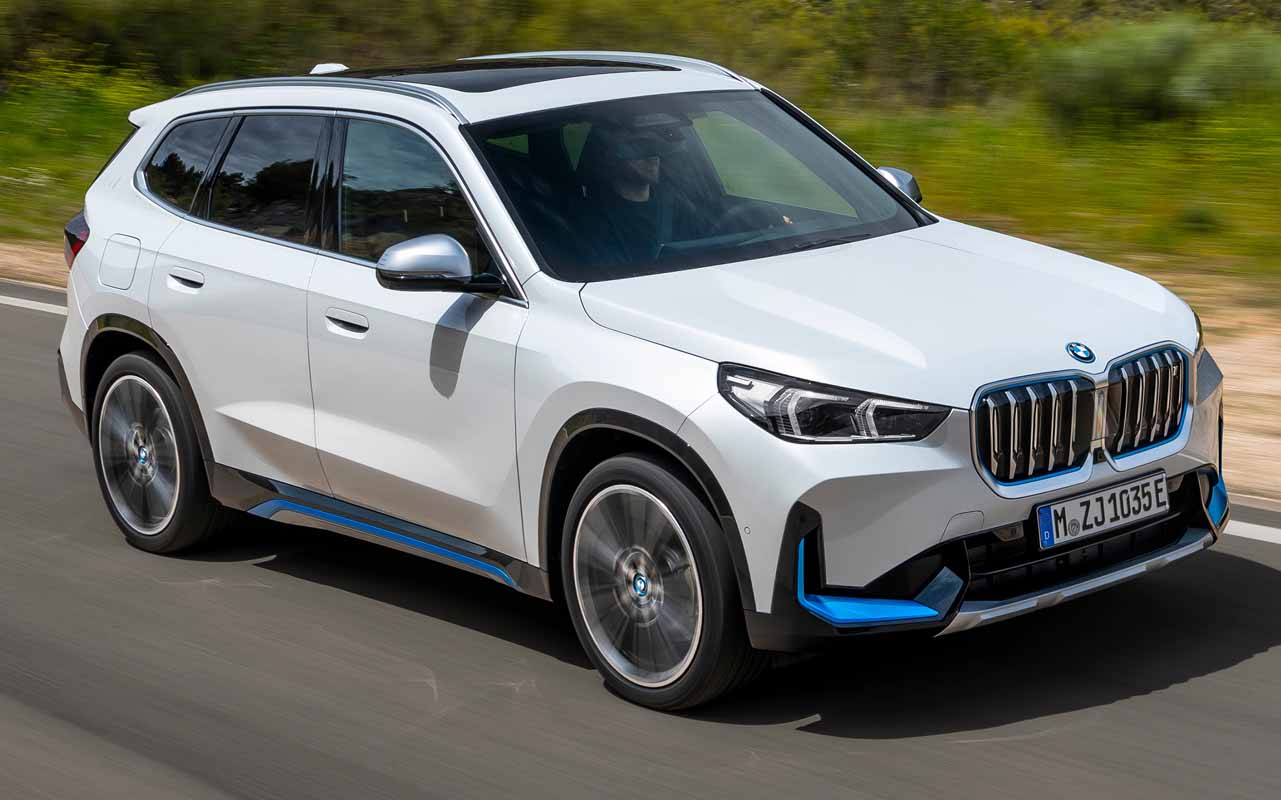
Upright front end increases the car’s physical presence
The upright front end of the new BMW X1 gives it significant visual presence. At the centre of the front end stands the large, almost square BMW kidney grille, its contouring highlighted by the three-dimensional chrome surround. The mighty kidney grille bars are finished in Black high-gloss as standard. In the outer areas of the lower air intake, large chrome strips accentuate the classy design of the front end. Flared wheel arches emphasise the width of the new BMW X1, while the precise lines and the clean, monolithic surfaces of the front apron underscore its modern character and robust stance.
The slim headlights extend well into the sides of the car. The new BMW X1 comes as standard with LED headlights for low and high beam. A fresh interpretation of the distinctive light graphic splits the headlights into three units for the low beam, high beam and daytime driving lights. Positioned to the outside, the daytime driving light units also include the turn indicators. Chrome detailing in the customary L shape emphasises the concentrated expression of the headlight units familiar from other BMW models.
Adaptive LED Headlights with striking light effects
The Adaptive LED Headlights available as an option also include the cornering light function, non-dazzling matrix high beam, urban lights, a motorway beam pattern and bad weather light. At speeds above 70 km/h (43 mph), high beam automatically adjusts to the road situation at hand. To this end, the relevant LED unit is split into 12 segments which can be activated and deactivated independently of one another. This matrix function allows dazzling of other road users to be avoided. The urban light distribution function of low beam optimises illumination of the road edges, and the motorway beam pattern increases the range of the lights. The bad weather light adapts the low-beam light distribution specially to deal with poor visibility, taking on the task previously carried out by the front fog lights. This also paves the way for generously proportioned surfacing around the front apron.
On cars specified with the Adaptive LED Headlights, the turn indicators optimise the car’s visibility on the road with their pulsating light signals. Also included with this option is an eye-catching Welcome and Goodbye show produced by the headlights and rear lights when the driver approaches the car or when the doors have just been locked.
Dynamically stretched silhouette, powerful rear section
The vertically designed front end also enhances the visual presence of the BMW X1 when viewed from the side. Crisply sculpted surfaces for the wheel arches, doors and shoulders of the body generate an expressive interplay of light and shadow. A dynamically rising character line connects the front and rear wheel arch borders. The long roofline flows into a spoiler extending a long way out to the rear. Together with the shoulderline above the flush door openers, which extends from the front wheel arches into the rear lights, this gives the silhouette a dynamically stretched feel. Shallow roof rails in Satin Aluminium or Black high-gloss are available as an option for the new BMW X1.
At the rear of the new BMW X1, sculptural surfaces exude power and solidity. Horizontal lines, the narrow rear window and flared wheel arches emphasise the width of the body. Chrome side details and a prominent underride protection element in the rear apron reprise styling cues from the front end. All the functions of the rear lights work using LED technology as standard. The homogeneous light from the rear units appears to shine directly out of the glass covers. If the Adaptive LED Headlights are specified, the rear lights also illuminate in an extremely striking “L” shape. These optional rear lights are also recognisable from the distinctive patterning in the sections extending into the sides of the body.
Robust looks and an air of sophistication: the xLine model
As an alternative to base specification, the new BMW X1 can also be ordered in xLine or M Sport form. The specific design elements of xLine underline the robust yet also sophisticated character of the compact SAV with features including exclusive light-alloy wheels in 18-inch format, dark grey body edging, BMW Individual Exterior Line Satin Aluminium and exterior mirror caps in Glacier Silver.
The surrounds for the BMW kidney grille and kidney grille bar fronts on the xLine model are finished in in Pearl-effect Chrome, as are the side trim pieces and stylistic underride protection at the front and rear aprons. xLine specification also includes aluminium door sill cover strips, seat surfaces in Sensatec perforated, illuminated interior trim strips in Black high-gloss and Sensatec surfaces for the door shoulders and upper section of the instrument panel.
Sharpening the dynamic edge: the M Sport model
Large cooling air inlets in the sides of the front end and a striking rear apron with integral diffuser element mark out the dynamic aura of the M Sport model. In this specification, the new BMW X1 also gains exclusive 18-inch M light-alloy wheels, adaptive M suspension and M High-gloss Shadowline trim. The M-specific interior appointments include sport seats, an anthracite-coloured headliner and an M leather steering wheel with gearshift paddles.
Large selection of exterior colour shades and light-alloy wheels
Customers can choose from two solid and ten metallic paint finishes for the new BMW X1. And the new model generation can now also be ordered with a Frozen paint option with shimmering matt surface from BMW Individual, not to mention a wide variety of BMW Individual special paint finishes.
All variants of the new BMW X1 come as standard with 17-inch lightalloy wheels. 18-inch light-alloy wheels are fitted on xLine and M Sport cars, although these models can also be specified with 19-inch or – in a first for the BMW X1 – 20-inch wheels.
Interior and equipment
The changing of the guard between the outgoing generation of the BMW X1 and the new model brings advances for the interior including extra space for those on board and their luggage, enhanced practicality and, most prominently, a fundamental upgrade of the display and control/operation system. The new BMW iDrive vehicle experience based on BMW Operating System 8 represents a reimagining of the drivercentred cockpit design to focus on touch and voice control – via the BMW Curved Display and the BMW Intelligent Personal Assistant. The broadbased implementation of digitalisation enables the number of physical buttons, controls and switches required for intuitive operation to be significantly reduced. At the same time, the innovative style of the interior design brings a progressive flavour to the modern premium ambience, in which high-quality materials and precision workmanship also play a defining role.
A much broader selection of standard equipment than was offered by its predecessor and sophisticated options, some of which were only previously available in higher vehicle segments, also shine a spotlight on the thoroughly developed character of the new BMW X1. Standard specification includes a navigation system, two-zone automatic climate control, a raft of modern driver assistance systems, Park Assist including Reversing Assist Camera and numerous other innovative digital services which enhance both comfort and the driving pleasure for which BMW is renowned. The new BMW X1 is also available with the newly created equipment packages xLine and M Sport, which enable targeted individualisation of the car.
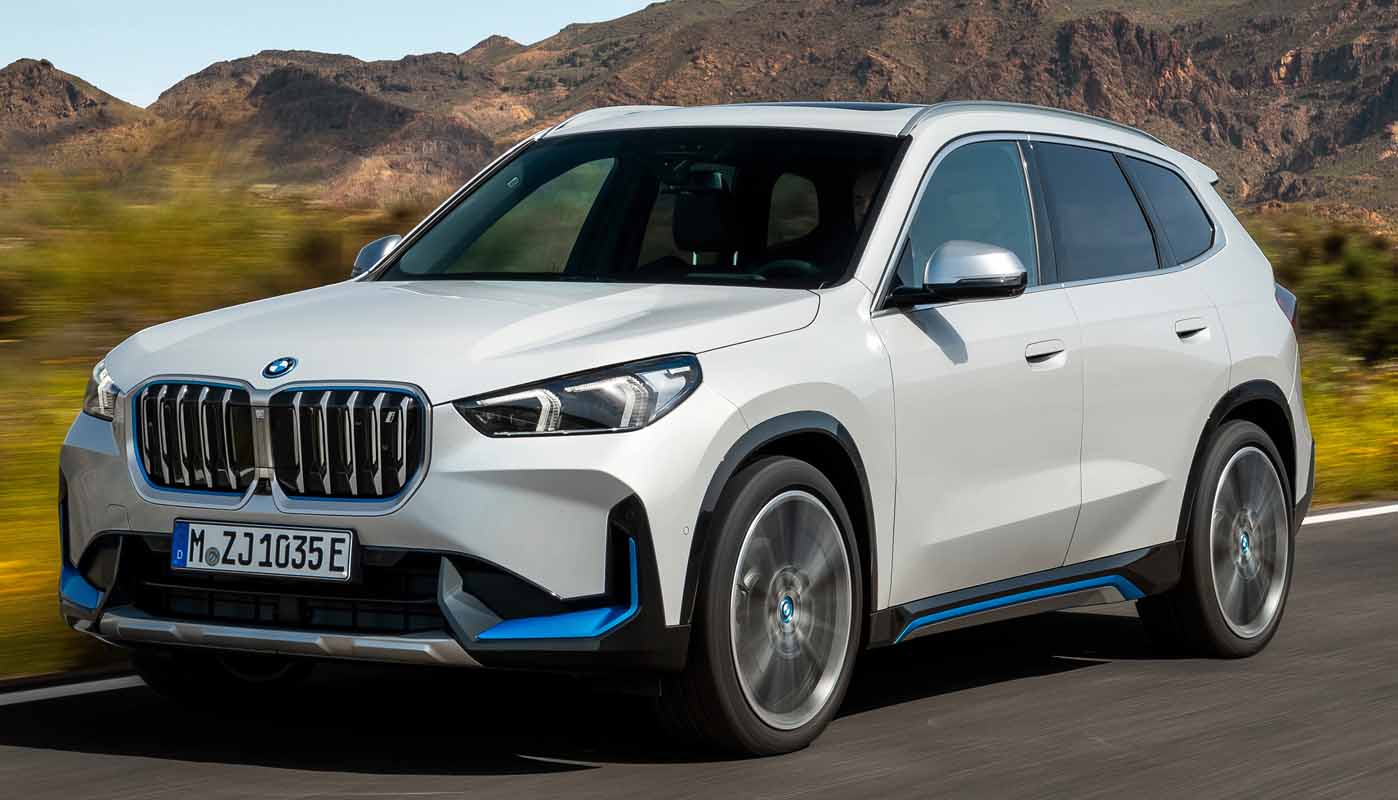
A generous feeling of space, widespread application of digitalisation
The raised seating position, generous amounts of space which can be utilised in a variety of ways, and a sense of cutting-edge functionality mark out the driving experience in the new BMW X1. The design of its interior focuses squarely on assured driving pleasure and versatility. The geometry of the interior and a large number of details take their cues from the interior concept of the BMW iX. Key features of this reinterpretation include the slender instrument panel, which serves as a stage for the BMW Curved Display, and a “floating” armrest with integral control panel.
The BMW Curved Display – with its frameless glass surface angled slightly towards the driver – brings a high-class, modern highlight to the cabin. It is framed by exceptionally solid-looking trim pieces which extend out to the doors as a border for the cockpit area. Below it, the slim instrument panel accentuates the width of the interior with its generously sized and horizontal decorative surfacing. Five interior trim strip variants, including the new open-pore fine eucalyptus wood and Aluminium Hexacube for the M Sport model, allow owners to individualise the design. Slim air vents ensure an extremely even distribution of fresh air around the interior. The side air vents are integrated into the A-pillars. The door trim elements with their sculptural shoulders and intricate door openers stand out with their clear and function-led design.
In the front section of the centre console, directly below the central air vent, is space for two cup holders and a smartphone tray with indirect illumination on both sides. Secured by a movable clasp, phones can be placed here upright and visible to the driver and front passenger, and charged wirelessly.
The space underneath the armrest is used as a storage compartment. Alongside the gear selector lever (which has a new, reduced design) in the integral control panel are exquisitely embedded buttons for using vehicle functions. These include the Start/Stop button, the volume control for the audio system and the button for the hazard lights. Among the other functions activated using the relevant buttons on the control panel are the parking brake, My Modes and Park Assist.
Newly developed seats offer even better comfort
The newly developed seats in the compact SAV offer classy looks, optimised comfort over long distances and extended functionality. This applies to both the standard items and the optional sport seats, which also stand out with their prominent bolsters and shoulder areas, and their adjustability of seat angle and depth. Seat heating can be specified as an option, as can electric adjustment (including memory function) for the fore-and-aft position, , and cushion/backrest angle for both the standard seats and sport seats. The two seat variants are also available with lumbar support in the backrest including massage function.
Available as alternatives to the standard anthracite-coloured cloth upholstery are the Sensatec perforated variant and Vernasca leather with attractive quilting. Customers can choose from the colours Black, Mocha and Oyster for each variant. The Sensatec surfaces are also available in bi-colour Red/Black. The M Sport package brings Sensatec/Alcantara sport seats in black with blue contrast stitching or – as an option – Vernasca leather with special diamond quilting.
The rear compartment of the new BMW X1 includes three full-sized seats with noticeably greater seat comfort than that offered by the predecessor model. ISOFIX child safety seat fasteners are integrated into the outer seats, and the 40 : 20 : 40 split rear seat backrests can be folded down to expand the boot capacity. The backrest angle of the three seat elements can be adjusted separately and through several stages, allowing either seating comfort or boot capacity to be increased. The fore-and-aft adjustment of the rear seat bench available as an option for the purely combustion-engined models provides even greater versatility. The individual sections of the 60 : 40 rear seat bench can slide forward or back through up to 13 centimetres either separately or together.
This allows the boot capacity of the new BMW X1 to be expanded from 540 litres to as much as 1,600 litres, as required. The all-electric BMW iX1 and plug-in hybrid models offer load capacity of 490 – 1,495 litres. A trailer tow hitch can also be ordered as an option for the new BMW X1, and this is now operated electrically at the touch of a button. The maximum permitted trailer load is as much as 2,000 kilograms, depending on the model variant (BMW iX1: 1,200 kilograms – provisional value).
Two-zone automatic climate control and navigation system as standard
Two-zone automatic climate control comes as standard in the new BMW X1, as does the rain sensor with automatic headlight activation. This system enables separate adjustment of the desired temperature on the driver’s and front passenger side of the car. It is operated using voice control or by touch from the control display. Depending on the car’s specification, the intelligent system can also incorporate the seat and steering wheel heating into the temperature control process. The automatic climate control system in the BMW iX1 works using extremely efficient heat pump technology. The all-electric model also comes as standard with an auxiliary climate control system to heat or cool the interior before a journey.
A Bluetooth interface, four USB-C ports and a 12V power socket in both the centre console and the boot all come as standard in all variants of the new BMW X1. The likewise standard BMW Live Cockpit Plus includes the cloud-based navigation system BMW Maps and an audio system with six speakers and amplifier output of 100 watts. The optional Harman Kardon Sound System raises the number of speakers to 12 and the amplifier output to 205 watts. Its tweeters are integrated into the door trim under high-quality stainless steel covers.
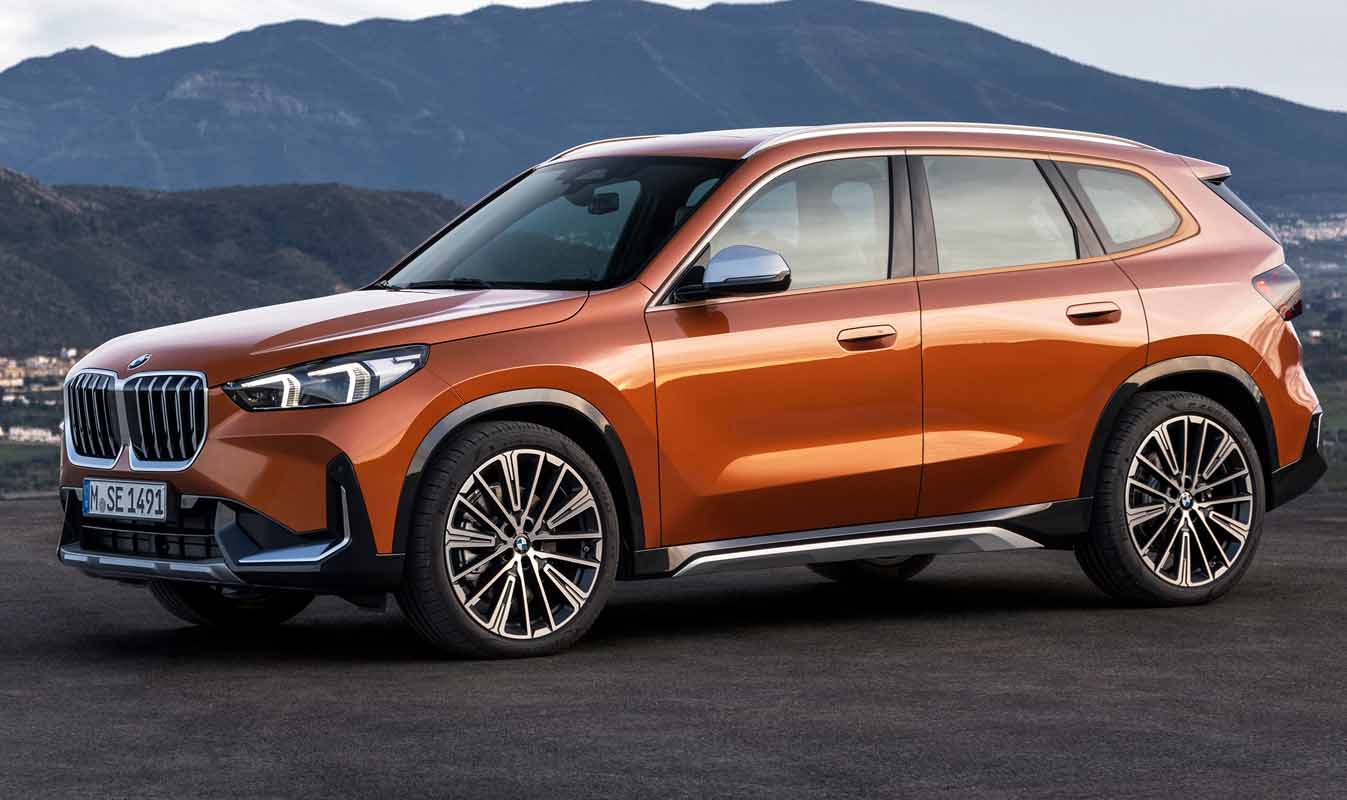
Premium ambience with room for extensive individualisation
The latest version of the standard Sport leather steering wheel has extremely high-quality accent trim in Pearl-effect Chrome, large thumb rests and multifunction buttons. If the M Sport package is specified, the new BMW X1 will offer drivers an M leather steering wheel with arresting three-spoke design and shift paddles. Steering wheel heating is available as an option for both items.
The surfaces of the instrument panel and front door shoulders can be specified as an option in Sensatec with eye-catching contrast stitching. Also available as an option is a mirror package, which adds light projections from the exterior mirrors, an electric folding function for the exterior mirrors and an automatic dimming function for the interior mirror and the exterior mirror on the driver’s side.
The standard interior lighting incorporates the footwells, the door openers and the storage compartments in the centre console, plus reading lights, the ambient light from the headliner and the door courtesy lights. The optional ambient lighting provides richly atmospheric interior illumination. The lighting’s distribution, brightness and colour scheme can be configured in the iDrive menu. And this option also includes the Dynamic interior light function, whose pulsating light signals indicate an incoming phone call or an open door when the engine is running.
With a glass surface measuring around one square metre, the optional panoramic glass sunroof offers an array of possibilities when it comes to flooding the interior of the new BMW X1 with light and fresh air. The roller blind cover for the glass roof now has a multi-layer design and, like the glass panel itself, is electrically operated.
Drive system and charging technology
The new BMW X1 offers a full spectrum of drive systems underpinned by cutting-edge power unit technology and a firm commitment to electrification. The petrol and diesel engines are all members of the BMW Group’s new modular generation of Efficient Dynamics engines, with the latest (second-generation) 48V mild hybrid technology ensuring highly responsive power delivery and increased efficiency. Meanwhile, locally emission-free driving pleasure is provided by the fifth-generation BMW eDrive technology fitted in both the all-electric BMW iX1 and the plug-in hybrid variants of the compact Sports Activity Vehicle.
The new BMW X1 will be launched with a choice of two petrol and two diesel engines featuring BMW TwinPower Turbo technology, whose drive power will be relayed via a seven-speed Steptronic transmission with double clutch as standard. From there it will be channelled to the road via either the front wheels or the BMW xDrive intelligent all-wheeldrive system that comes as standard on the most powerful petrol and diesel models.
The BMW iX1: pure-electric driving pleasure in a compact SAV
An all-electric variant will be added to the new BMW X1 line-up immediately after launch. The BMW iX1 xDrive30 is the first all-wheeldrive electric car introduced by the brand in the premium compact segment. It represents the latest instalment in the BMW Group’s ongoing all-electric model offensive and brings the appeal of locally emission-free driving pleasure to a wide target audience.
The BMW iX1 xDrive30 is powered by one electric motor at the front axle and another at the rear, each sitting together with the accompanying power electronics and transmission within a single, very compact housing. These highly integrated drive units deliver a combined output of 230 kW/313 hp (including temporary boost) and post overall torque of 494 Nm (364 lb-ft). The power-to-weight ratio of both the eDrive 5.0 M170SF drive unit at the front axe and the eDrive 5.0 M170SR drive unit at the rear is 1.5 kW/kg. This creates an electric all-wheel-drive system in which the precisely orchestrated interaction between the two motors produces alluringly instantaneous acceleration combined with supreme traction and directional stability.
The BMW iX1 xDrive30 reaches the 100 km/h (62 mph) mark from rest in 5.7 seconds, on the way to a top speed of 180 km/h (112 mph).
The fifth-generation BMW eDrive technology also comprises the car’s charging technology and the high-voltage battery positioned flat within the vehicle’s underbody, which provides 64.7 kWh of usable energy. The battery’s high energy density of 152 Wh/kg in relation to its weight or 199 Wh/l in relation to its volume, and the drive system’s excellent efficiency, with combined electric power consumption in the WLTP cycle of 18.4 – 17.3 kWh per 100 kilometres, form the basis for a range of 413 – 438 kilometres (257 – 272 miles).
The Combined Charging Unit in the BMW iX1 xDrive30 enables singleand three-phase AC charging at a rate of up to 11 kW, which can be optionally increased to up to 22 kW (three-phase AC). This allows the high-voltage battery to be fully recharged from empty in 6.5 hours as standard and in just 3 hours 45 minutes as an option. DC power can be taken on board at a rate of up to 130 kW, making it possible to boost the high-voltage battery’s energy reserves from 10 to 80 per cent of total capacity in the space of 29 minutes. Within this charge level range, enough energy can be sourced from a high-power-charging point in just ten minutes to increase range by 120 kilometres / 75 miles.
Combined Charging Unit and improved charging software
The Combined Charging Unit in the BMW iX1 brings together the functions of the voltage transformer, charging electronics and power distribution, plus the management systems for the drive, high-voltage and charging functions, into a single package. The highly integrated control unit keeps the electric drive system fed with an extremely effective, precision-controlled supply of energy, while also ensuring the high-voltage battery is charged quickly and efficiently. As in the BMW i7, the charging software has benefitted from further refinement. Once the high-voltage battery reaches a higher charge level, the new charging process aims to ensure the charging rate drops smoothly instead of following the previous “stepped” curve. This produces a more rounded charging curve overall, resulting in even shorter charging times. So following an initial, temperature-dependent phase of constant power supply, the new process now controls charging based on a continuous nominal voltage curve that makes allowance for the variables of temperature, recharged capacity and the charge level at start of charging.
An optimised cooling strategy for DC charging further improves the durability of the high-voltage battery. Alternating phases of full and partial cooling power are used when charging the BMW iX1 to avoid excessive cooling of the battery during fast charging. This prevents cell temperatures from dropping too low while fast charging is in progress, particularly at higher charge levels, thereby opening up potential for short charging times and reduced ageing of the high-voltage battery’s cells. It is also possible to store customised charging settings for multiple individual charging points. These settings will then be automatically restored the next time the car returns to a memorised charging point. In addition, preheating of the high-voltage battery can also now be started manually in the BMW iX1 when approaching a DC charging station without the navigation system’s route guidance function activated.
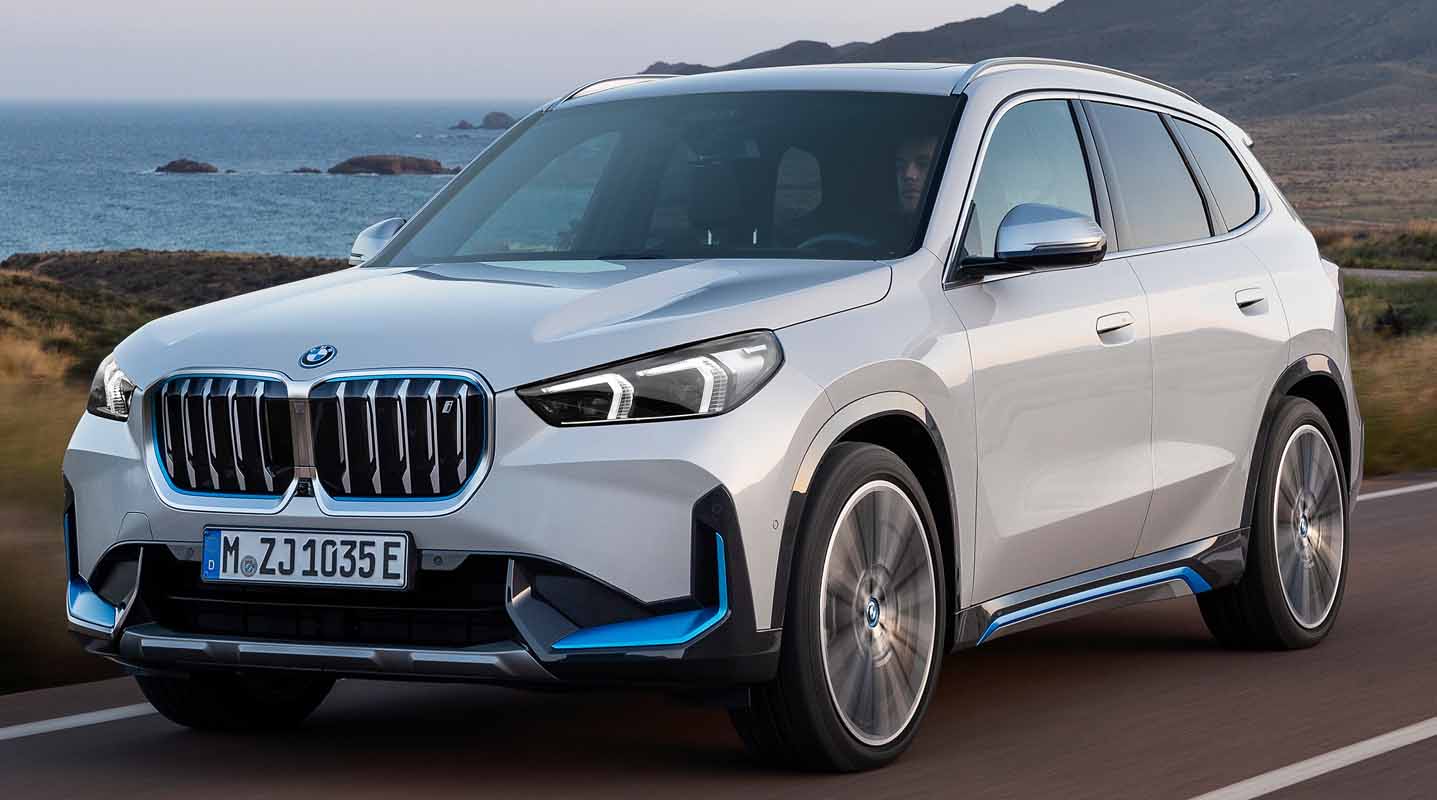
Efficiency through electrification: 48V mild hybrid technology
Electrification also helps to increase the efficiency of the combustion engines in the new BMW X1 xDrive23i and BMW X1 xDrive23d, at the same time as playing a role in their extremely sporty power delivery. Their second-generation 48V mild hybrid technology comprises an electric motor integrated into the seven-speed Steptronic transmission with double clutch, which acts as a starter generator and is able to both ease the load on the engine and act in unison with it. It produces nominal power of 14 kW/19 hp and nominal torque of 55 Nm (41 lb-ft). Depending on the driving situation, the electric motor delivers additional drive power that translates into exceptionally rapid response to the slightest movement of the accelerator, both when pulling away and when putting in a sudden burst of speed. The powerful starter generator also enables more comfortable operation of the Automatic Start/Stop and coasting functions.
Adaptive recuperation with intelligent control
The energy required for providing the electric power boost is stored in a 48V battery located under the luggage compartment. As well as the electric motor, it also supplies the car’s 12V electrical system via a voltage transformer. The 48V battery is charged by means of adaptive recuperation in overrun and braking phases at a rate of up to 15 kW. This provides an efficient means of recuperating previously unused kinetic energy generated by braking. Here, the system uses data from the navigation system – even when route guidance is not activated – and driver assistance system sensors. In this way, upcoming roundabouts or vehicles travelling in front, for example, can be detected in order to adapt deceleration accordingly as soon as the driver takes their foot off the accelerator.
The drive system of the fully electric BMW iX1 can also use adaptive recuperation geared to the driving situation and route profile at hand to recover kinetic energy during a journey and feed it into the high-voltage battery. The maximal recuperation power attainable in driving mode B through use of the accelerator alone is 60 kW. Recuperation power of up to 120 kW can be generated via the brake pedal regardless of the driving model selected.
Petrol engines with greater fuel efficiency and lower emissions
The BMW X1 sDrive18i and BMW X1 xDrive23i are powered by petrol engines with three and four cylinders from the BMW Group Efficient Dynamics engine family’s new modular generation. The array of innovations that enhance their efficiency and emissions performance, in particular, include the Miller cycle (which shortens the opening time of the intake valves), redesigned intake ports and combustion chambers, and an ignition system featuring an active coil with integrated electronics. Mixture preparation is optimised using a new dual injection system. In addition to the existing high-pressure injection system, some of the fuel is now injected into the combustion chambers via a lowpressure system. At the same time, the effectiveness of the turbocharging system and intercooler has also been increased.
The 2.0-litre four-cylinder unit and 48V mild hybrid technology in the new BMW X1 xDrive23i give it a maximum output of 160 kW/218 hp (developed by the combination of the combustion engine with up to 150 kW/204 hp at 5,000 – 6,500 rpm and the integrated electric motor with up to 14 kW/19 hp) and peak torque of 360 Nm/265 lb-ft (developed by the combination of the combustion engine with up to 320 Nm/236 lb-ft at 1,500 – 4,000 rpm and the integrated electric motor with up to 55 Nm/41 lb-ft). This results in a 0 to 100 km/h (62 mph) acceleration time of 7.1 seconds. This spirited power delivery does not come at the expense of efficiency, with combined fuel consumption of 7.2 – 6.5 litres per 100 kilometres (39.2 – 43.5 mpg imp) and CO2 emissions of 162 – 146 grams per kilometre in the WLTP cycle.
The upgraded three-cylinder engine in the new BMW X1 sDrive18i, meanwhile, extracts maximum output of 100 kW/136 hp and maximum torque of 230 Nm/170 lb-ft from its 1.5-litre capacity. This enables the car to sprint from 0 to 100 km/h (62 mph) in 9.2 seconds. The combined fuel consumption and CO2 emissions figures as measured in the WLTP test cycle come in at 7.0 – 6.3 litres per 100 kilometres (40.4 – 44.9 mpg imp) and 158 – 143 grams per kilometre.
Diesel engines with further improvements to efficiency
The 2.0-litre four-cylinder diesel units fitted in the new BMW X1 xDrive23d and BMW X1 sDrive18d have also undergone an extensive upgrade, and now feature low-friction pistons made from tempered steel, a graphite coating for the piston skirts and an active oil separator with map-regulated electric drive. In an effort to further cut fuel consumption and emissions, improvements have also been made to the efficiency of the two-stage turbocharging and to the common-rail injection and exhaust gas recirculation systems.
Combining these advances with 48V mild hybrid technology allows the new BMW X1 xDrive23d to deliver maximum output of 155 kW/211 hp (developed by the combination of the combustion engine with up to 145 kW/197 hp at 4,000 rpm and the integrated electric motor with up to 14 kW/19 hp) together with peak torque of 400 Nm/295 lb-ft (developed by the combination of the combustion engine with up to 400 Nm/295 lb-ft at 1,500 – 2,750 rpm and the integrated electric motor with up to 55 Nm/41 lb-ft). The sprint from 0 to 100 km/h (62 mph) takes 7.4 seconds. The car’s superior efficiency is reflected in combined fuel consumption and CO2 figures of 5.4 – 4.8 litres per 100 kilometres (52.3 – 58.9 mpg imp) and 142 – 125 grams per kilometre in the WLTP cycle.
Thanks to the new version of the 2.0-litre four-cylinder diesel engine developing maximum output of 110 kW/150 hp and peak torque of 360 Nm/265 lb-ft, the BMW X1 sDrive18d reaches 100 km/h (62 mph) from a standstill in 8.9 seconds. At the same time, it posts combined fuel consumption and CO2 emissions of 5.5 – 4.9 litres per 100 kilometres (51.4 – 57.7 mpg imp) and 145 – 129 grams per kilometre, as measured in the WLTP test cycle.
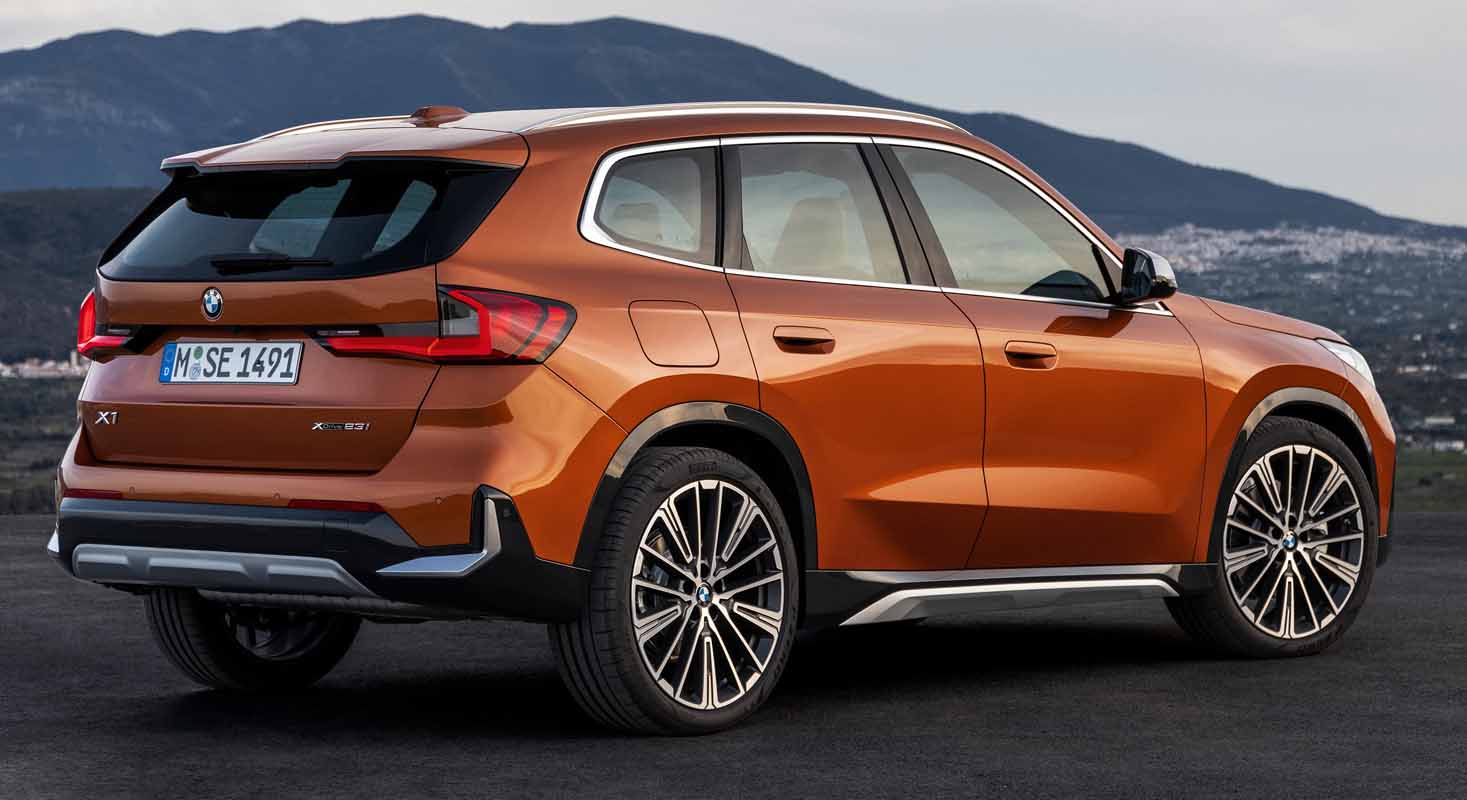
Standard: seven-speed Steptronic transmission with double clutch
All the petrol and diesel engines available for the new BMW X1 are mated to a seven-speed Steptronic transmission with double clutch as standard. The latest generation of the automatic transmission stands out with its fully electric actuation, widened gear ratio spread and greater internal efficiency, while also tailoring the shift strategy to the route topography and enabling the coasting function to now be used in all My Modes with the exception of Sport Mode in the transmission position S. Integrating the electric motor into the transmission on models with 48V mild hybrid technology allows its extra power to be made available exceptionally quickly and also ensures high levels of efficiency-boosting energy recuperation.
The seven-speed Steptronic transmission with double clutch forms the basis for remarkably fast, harmonious gear changes that are also executed very smoothly. It combines two sub-transmissions within a single housing, enabling it to pre-select the next gear prior to each gear change. And the transmission automatically shifts into P when the engine is switched off. If the car is parked on a slope, this is detected using a sensor and the electric parking brake is automatically applied.
Optionally, gearshift paddles on the steering wheel enable extremely rapid manual gear changes. In M Sport examples of the new BMW X1, the four-cylinder engines link up with a version of the seven-speed Steptronic transmission with double clutch which has particularly dynamic shift characteristics and can likewise be operated using shift paddles on the steering wheel. In addition, M Sport specification includes the Sport Boost function for all new BMW X1 models. When the driver pulls the left-hand shift paddle for at least a second, all the powertrain and chassis settings are primed to maximise their sporting responses.
Two plug-in hybrid models due to join the range
Two plug-in hybrids will be added to the new BMW X1 model line-up immediately after launch. Their electric drive components are also the product of fifth-generation BMW eDrive technology, which means significant advances over the preceding generation in terms of sporting prowess, efficiency, electric range and charging capacity. The BMW X1 xDrive30e (fuel consumption combined: 1.1 – 0.8 l/100 km [256.8 – 353.1 mpg imp]; electric power consumption combined: 18.2 – 16.4 kWh/100 km; CO2 emissions combined: 24 – 17 g/km in WLTP cycle) and BMW X1 xDrive25e (fuel consumption combined: 1.1 – 0.8 l/100 km [256.8 – 353.1 mpg imp]; electric power consumption combined: 18.2 – 16.4 kWh/100 km; CO2 emissions combined: 24 – 17 g/km in WLTP cycle) both feature a highly integrated electric drive unit powering the rear wheels, combined with a three-cylinder petrol engine that drives the front wheels via the seven-speed Steptronic transmission with double clutch.
Maximum output is 240 kW/326 hp in the BMW X1 xDrive30e (developed by the combination of the combustion engine with up to 110 kW/150 hp and the electric motor with up to 130 kW/177 hp) and 180 kW/245 hp in the BMW X1 xDrive25e (developed by the combination of the combustion engine with up to 100 kW/136 hp and the electric motor with up to 80 kW/109 hp). Now positioned flat in the vehicle floor, the fifth-generation lithium-ion high-voltage batteries have an increased usable energy content of 14.2 kWh. At the same time, maximum charging capacity has climbed from 3.7 kW on the outgoing model to 7.4 kW, enabling the high-voltage battery to be fully recharged from empty in 2.5 hours. When hooked up to a conventional domestic power socket, a full vehicle charge is completed within eight hours. Electric range is now up to 78 – 89 kilometres (48 – 55 miles) in the WLTP cycle.
Increasing electric range by means of adaptive recuperation
As in cars with 48V mild hybrid technology and the BMW iX1, the adaptive recuperation function also enhances the efficiency of the plugin hybrid models. In order to recover kinetic energy as extensively as possible on the overrun and under braking, the route profile is factored in using data from the navigation system and driver assistance system sensors.
As soon as the driver lifts off the accelerator, up to 50 kW of electric energy can be fed back into the high-voltage battery. The recuperation power of the plug-in hybrid models under braking is up to 80 kW. The degree of recuperation is determined by the My Modes selected. Adaptive recuperation is activated in Personal Mode and Efficient Mode. In Sport Mode, recuperation remains constant along a fixed curve.
BMW xDrive: assured power transfer for all types of drive system
The BMW xDrive system intelligently controls the distribution of power to all four wheels to maximise traction, agility and directional stability in all weather and road conditions, irrespective of the drive system at hand. The two electric motors acting on the front and rear axles in the BMW iX1 xDrive30 create an electric all-wheel-drive system. Interaction between the two motors is enhanced by a unique drive torque control system integrated into the Combined Charging Unit, which is interlinked with the DSC and the AWD-specific version of the near-actuator wheel slip limitation function. This allows the drive power requested by the driver to be split between the two motors to ensure exactly the right levels of traction and directional stability, dynamic performance and efficiency for the situation at hand. The control speed of BMW traction control is 10 times faster than other systems on the market. The driver perceives the control process as significantly more comfortable.
In many driving situations, traction, directional stability and dynamism can be increased simply by altering the distribution of power between the front and rear motor, without the need for any further intervention. When pulling away and accelerating, for example, the requested drive power is provided by both motors for optimum traction. If the accelerator is pressed with moderate pressure, an increasing proportion of the power will come from the front drive unit as the pace picks up – in order to optimise efficiency and increase range – until the vehicle is travelling at a steady speed and being driven purely via the front wheels. Thanks to the innovative drive torque control system, the rear motor will instantly cut in again in response to a sudden request for power or the need for optimised traction or directional stability, as registered through the interplay with the DSC system. When taking corners at speed, for example, the proportion of rear-wheel drive is increased, reducing the drive power transmitted through the front wheels and thereby allowing them to absorb higher cornering forces.
In the plug-in hybrid models, meanwhile, the data obtained by the DSC system on wheel speed, steering angle, road speed, longitudinal and lateral acceleration, and vehicle yaw rate again provides the basis for precisely controlling the combined effect of the combustion engine and electric motor. As a result, their hybrid-specific version of the BMW xDrive system is also capable of delivering exhilarating propulsive power in any driving situation. The all-wheel drive in the BMW X1 xDrive23i and BMW X1 xDrive23d models is likewise linked with the chassis control systems at all times. Here, a power take-off bevel gear on the front axle, a dual-section propeller shaft and a rear axle differential with an electrohydraulically controlled hang-on clutch are used to efficiently split drive torque between the front and rear wheels as the situation demands. In driving situations that do not require all-wheel drive, the engine’s power is sent to the front wheels only. In adverse road conditions or highly dynamic driving situations, the hangon clutch shifts drive power to the rear wheels in fractions of a second, in order to significantly enhance traction, directional stability and the sporting ability for which BMW is renowned.
Chassis technology and driving experience
The powertrain and chassis technology on board the new BMW X1 gives it all the tools it needs to put driving pleasure at the customer’s fingertips and provide a standout all-round ownership proposition. With its sporty, agile handling in everyday use, ability to make unruffled progress over rough terrain and compelling long-distance comfort, the compact Sports Activity Vehicle delivers a sweetly balanced, well-resolved driving experience in any situation.
Featuring a body construction that reduces weight while increasing rigidity, as well as a substantial increase in wheelbase length and track width compared with its predecessor, the car’s basic design provides the ideal blueprint for the job at hand. In the development of the axles, steering, springs and dampers, and the integrated application of all the powertrain and chassis systems, the engineers took particular care to ensure all model variants of the new BMW X1 offer the handling characteristics for which the brand is renowned. Irrespective of the drive system fitted and the resulting weight distribution, they all boast incredibly sporty handling for their class at the same time as offering precise controllability, even in demanding driving situations. All models are equipped as standard with near-actuator wheel slip limitation for enhanced traction and directional stability. And other new features include the integrated braking system and the frequency-selective damping for the optional adaptive M suspension.
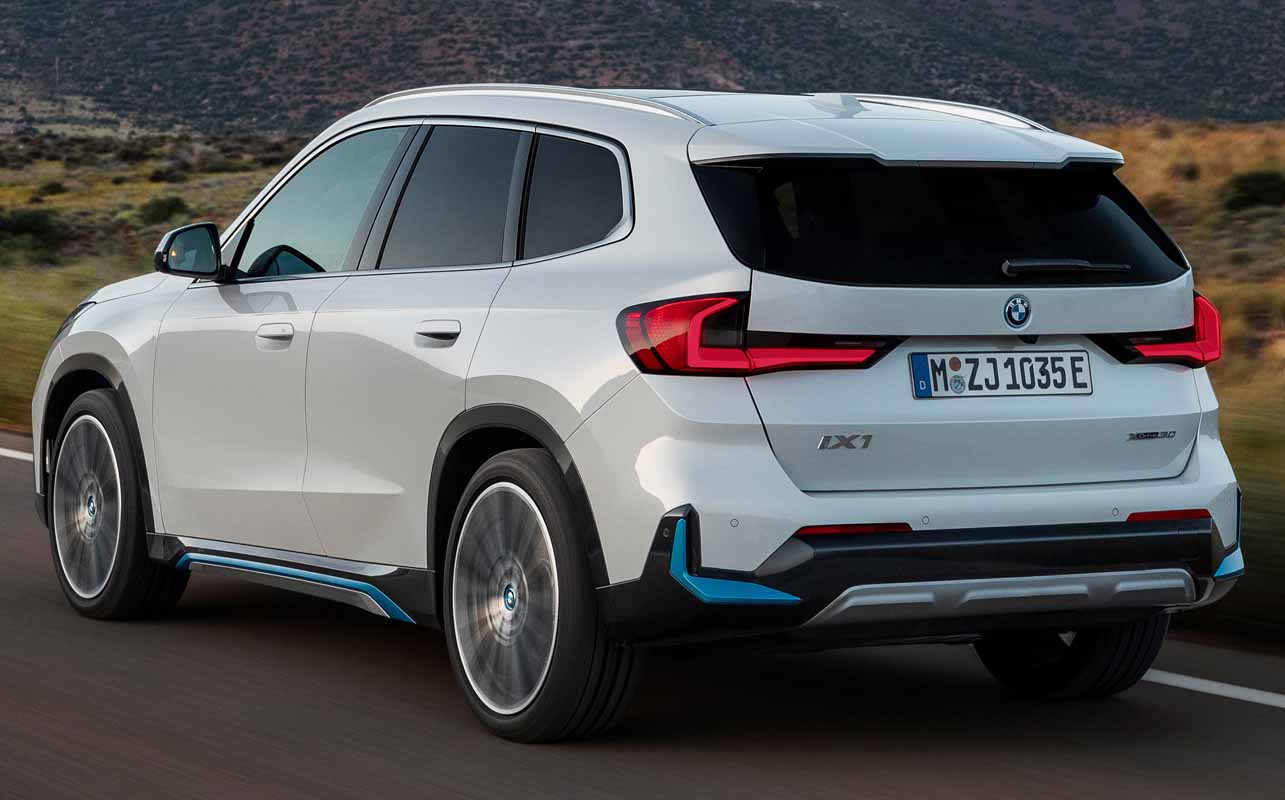
Newly developed componentry for front and rear axle
The new BMW X1 has adopted its predecessor’s design principle for the front and rear axle. However, all components of the single-joint spring strut axle at the front have been developed almost completely from scratch. The new axle kinematics and increased rigidity help to give the car agile turn-in response and steering feel that is largely unaffected by torque steer. The supports for the hydromounts are now made from aluminium, shaving around three kilograms off the vehicle’s weight. Following readjustment of the steering axle, the caster offset has been increased by some 15 per cent over the predecessor model, which has a positive effect on both steering feedback and straight-line stability.
The modular three-link rear axle fitted on all model variants also has the ideal ingredients for sporty handling. Featuring a bespoke design with remarkably high rigidity, it is partnered by a rear-axle subframe with a rigid mounting and promises precise wheel guidance even under high lateral acceleration. The springs and dampers take up less space thanks to their separate arrangement, freeing up additional room both for passengers in the rear and in the luggage compartment. The use of antiroll bar mounts with high preload on both axles improves not just roll stabilisation, but also steering precision during dynamic cornering. A new wheel bearing design that minimises both friction and weight is an additional factor in the superior efficiency of the new BMW X1.
The rear-axle subframe’s flexible construction enables the new BMW X1 to accommodate different types of drive system. Consequently, the rearaxle subframe on the BMW iX1 xDrive30 and the plug-in hybrid models features bespoke mounts for the electric drive unit powering the rear wheels. An additional mounting for the high-voltage battery has also been included on these electrified models.
The suspension and damping systems in the new BMW X1 have also undergone an extensive upgrade with a view to enhancing long-distance comfort. For the first time, the front axle has been equipped with extra, lift-related damping using an additional sleeve on the dampers. This reduces body movement when driving over small bumps, while also ensuring excellent transient behaviour in corners.
Adaptive M suspension with frequency-selective damping, a 15-millimetre drop in ride and sport steering
Adaptive M suspension is available as an option for all model variants of the compact SAV, including the plug-in hybrids, and is fitted as standard on the BMW iX1 xDrive30. Both agility and long-distance comfort benefit from this suspension system’s mechanically controlled adjustable and frequency-selective dampers. Pressure peaks inside the dampers are smoothed out with the help of additional valves that are active on the rebound side. As a result, the system offers comfortable response when absorbing minor bumps in the road surface combined with sporty damper characteristics in dynamic driving situations. The specially designed damper system brings about a 15-millimetre drop in ride on all models.
And sport steering is part of the adaptive M suspension specification on all variants too. This particular version of the Electric Power Steering system features a more direct rack ratio, along with the Servotronic speed-sensitive power assistance also included with the standard steering.
Near-actuator wheel slip limitation for extremely quick, precise response
The new BMW X1 also now comes with near-actuator wheel slip limitation to maximise the car’s agility and composure in challenging driving situations. Unique in this segment, this traction control system is integrated into the engine management, eliminating the long signal paths to the DSC control unit. This allows corrective inputs to be applied up to ten times faster than in conventional systems and with exceptional precision. Near-actuator wheel slip limitation thereby ensures optimum traction even on slippery roads, superb straight-line poise and assurance when accelerating hard, and excellent handling stability in corners. In addition, on all-wheel-drive models, power is split between the front and rear wheels as the situation demands.
Near-actuator wheel slip limitation likewise maintains directional stability when the vehicle is decelerating sharply as a result of energy recuperation. This means the electric drive units fitted in the new BMW X1 models can continue to regenerate brake energy to maximum effect even in adverse road conditions.
The functions provided by the DSC system include not only anti-lock braking (ABS) and Dynamic Traction Control (DTC), but also a variety of stabilising functions and the drive-off assistant. The Performance Control function gives the car even more agile handling by varying the distribution of drive torque to the front wheels according to the situation at hand. In order to optimise directional stability during heavy braking on surfaces offering differing levels of grip for the right-hand and left-hand wheels, a steering impulse is applied to help the driver correct the car’s line. The functioning of the electromechanical parking brake is also integrated into the rear brake callipers by means of the DSC system.
Integrated braking system optimises handling characteristics
The new BMW X1 is equipped with an integrated braking system that delivers outstanding stopping power and superior pedal feel. This system brings together the brake activation, brake booster and braking control functions within a compact module. The required brake pressure is triggered using an electric actuator, an operating principle that generates pressure more dynamically and ensures significantly faster and more precise interventions by the DSC. The integrated braking system generates a degree of stopping power that is matched exactly to the driver’s inputs, while also providing excellent feedback via the brake pedal. The use of an electric actuator means braking requests from the driver assistance systems are likewise translated into extremely short stopping distances for improved active safety.
The braking system in the new X1 employs single-piston floating-calliper disc brakes at the front and rear. A brake pad wear indicator is also included as standard and provides precise information on the remaining service life of the brake pads in the operating system’s relevant menu.
All models in the new BMW X1 range ride on 17-inch light-alloy wheels as standard. The increase in the diameter of their tyres to 702 millimetres improves ride comfort at the same time as giving the vehicle greater visual presence when viewed from the side. The xLine and M Sport specifications both include 18-inch light-alloy wheels. The BMW iX1 is available with aerodynamically optimised light-alloy wheels, whose reduced air resistance helps to extend the car’s range. The optional 19- and 20-inch light-alloy wheel variants are fitted with tyres that are 20 millimetres wider than on the outgoing model to give the new BMW X1 greater dynamic handling potential. High-performance tyres are also available for models with adaptive M suspension.
The new BMW X1 additionally comes as standard with a tyre pressure indicator for each individual wheel that provides an early warning of any loss of pressure, as well as a digital tyre condition monitoring system. Unique in this segment, this function uses a cloud-based algorithm to detect pressure loss far sooner than the vehicle’s Tyre Pressure Monitor can. This is made possible by a diagnostics function in the BMW backend that has been implemented with the help of artificial intelligence (AI). The driver is notified of any pressure loss together with the recommended course of action via the My BMW App (depending on the market, they may also receive a Teleservice message). Statistical information and AI methods can also be employed to predict the wear behaviour of the vehicle’s tyres and thereby forecast the remaining tyre life until the recommended minimum tread depth is reached. The digital tyre diagnosis function can be set to automatically inform the customer of any tyre-related technical issue requiring action. Depending on the particular market, notification is sent via the vehicle in the form of a Teleservice message, by e-mail or via the My BMW App.
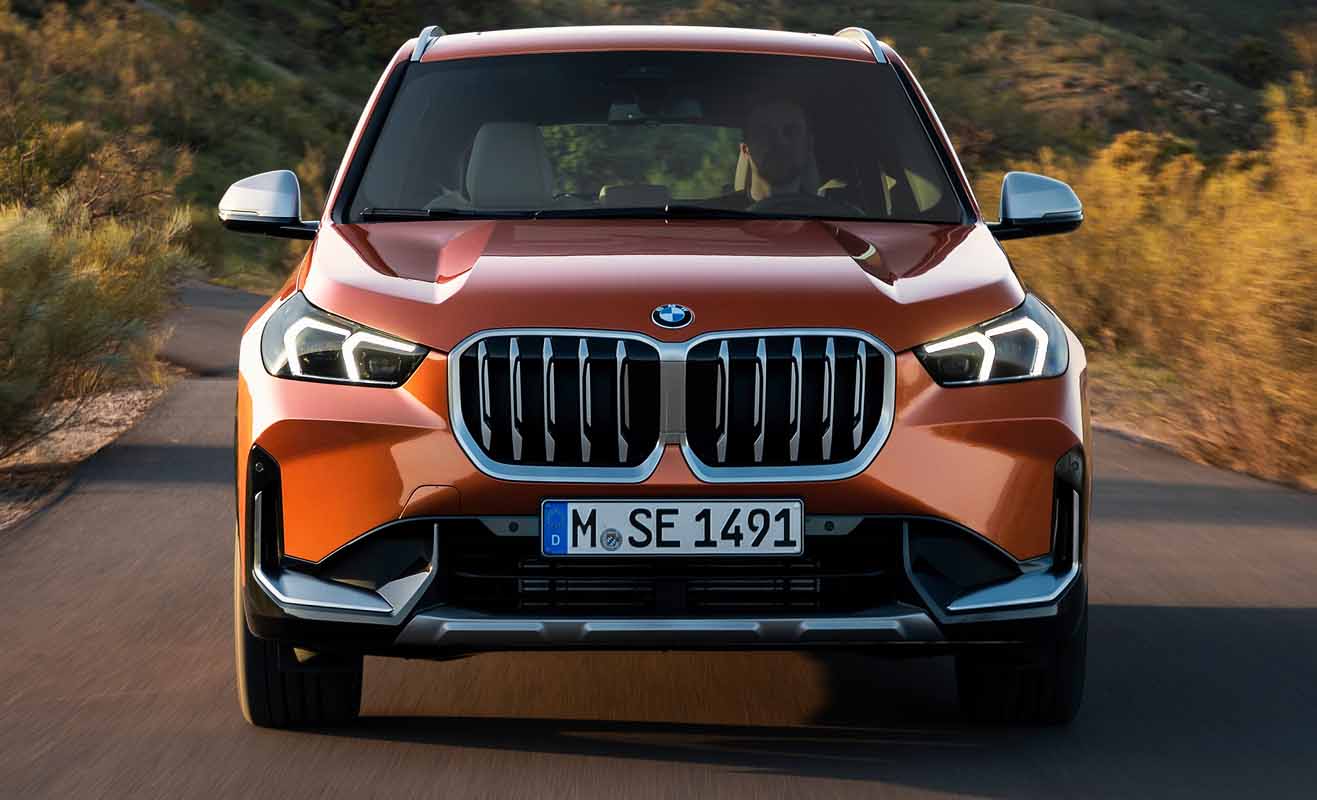
Driver assistance systems
Comfort and safety in the new BMW X1 are further enhanced by a significantly expanded selection of standard and optional driver assistance systems compared with the outgoing model. As far as functionality and availability are concerned, the automated driving and parking systems rank among the best on the market. They are designed to assist the driver or lighten their workload in a wide variety of situations. Camera images and the data gathered by ultrasonic and radar sensors are used to monitor the vehicle’s surroundings, to warn of potential hazards, to minimise the risk of an accident with corrective braking or steering inputs, and to perform automated parking and manoeuvring. Existing functions can be improved by means of the Remote Software Upgrades facility, which also lets customers add new functions – such as the Steering and Lane Control Assistant (availability depends on the hardware fitted in the vehicle and the market conditions) – at a later stage.
The new BMW X1 is fitted as standard with the latest version of the front-collision warning system with brake intervention, which brings additional functions to help prevent an accident. It comprises features such as Collision Warning, pedestrian and cyclist warning with braking function, and Crossroads Warning. And it can also warn the driver of pedestrians and cyclists who are parallel to the road and approaching the vehicle from the front or rear when turning right (in countries where vehicles drive on the right). The front-collision warning system also helps to increase safety when turning left (in countries where vehicles drive on the right). If a vehicle is approaching on the side of the road the driver needs to cross, visual and acoustic warnings are triggered and the brakes are applied to prevent the driver from continuing with their turnoff manoeuvre.
Cruise Control with brake function, Speed Limit Info with no-overtaking indicator and pre-warning, manual Speed Limit Assist and the Evasion Assistant are likewise all fitted as standard. Lane Departure Warning with lane return also comes as standard and is capable of analysing the prevailing road situation very precisely. On extremely narrow roads, the course correction assistance is suppressed so that if a vehicle is approaching from the opposite direction, the driver can easily move onto the side of the road.
Optional Driving Assistant with new exit warning function
The optional Driving Assistant additionally comprises the Lane Change Warning system, which helps the driver to guide the car back into the original lane, likewise by means of a steering input. The Driving Assistant’s features also include Rear Collision Prevention and rear crossing traffic warning, which reduces the danger of a collision when reversing towards roads that are difficult to see into.
There is also an exit warning function, which provides a safety boost when the vehicle is stationary. It activates warnings if a vehicle or cyclist is approaching the BMW X1 at speed and there is a risk of collision on either side of the vehicle. The driver or front passenger is alerted to the danger by flashing LEDs in the mirror or the ambient lighting. An acoustic signal is also emitted.
Automated Level 2 driving: Driving Assistant Plus
The optional Driving Assistant Plus offers targeted improvement of comfort and safety on long-distance journeys. This camera- and radarbased system includes the Steering and Lane Control Assistant as well as Active Cruise Control with Stop&Go function, which can both be used at speeds up to 180 km/h (112 mph). Corrective steering inputs help the driver to keep the vehicle in the lane detected by the system. Active Cruise Control is capable of not only maintaining the preferred speed, but also automatically keeping a safe distance from vehicles travelling ahead, and can brake the new BMW X1 to a halt if necessary.
The automatic Speed Limit Assist and route monitoring functions available when using Active Cruise Control add to the car’s Level 2 automated driving capabilities, as defined by SAE international standard J3016. Speed limits along the route detected either by the Speed Limit Info system or by using data from the navigation system can be anticipated in advance with the help of automatic Speed Limit Assist. Meanwhile, the route monitoring function also looks ahead to reduce the car’s speed as appropriate when approaching a corner, a roundabout, a junction or an exit. The system also adjusts the speed as required before entering built-up areas. After passing through the applicable section of the route at a suitable speed, the system will accelerate the new BMW X1 back up to the speed set by the driver or the current speed limit, as appropriate.
The complete comfort and safety package: Driving Assistant Professional
If the Driving Assistant Professional option is specified, both the Steering and Lane Control Assistant and Active Cruise Control will be available to use at speeds up to 210 km/h (130 mph). On motorways, the Steering and Lane Control Assistant can also help the driver to guide the car in situations where the lane narrows. The Active Navigation function detects when the vehicle needs to change lane in order to take a motorway exit and keep to the calculated route, and sets up the lane change. The system also features the Lane Keeping Assistant with active side collision protection. In Germany, traffic light recognition is also available when Active Cruise Control is in use.
The package of Driving Assistant Professional functions additionally includes Road Priority Warning, Wrong-way Warning, front crossing traffic warning, the Emergency Stop Assistant and the Emergency Lane Assistant (can be used in selected European countries). Assisted View in the instrument cluster gives the driver an overview of the activated systems and their functionality. To this end, the central area of the cockpit display is reserved for a three-dimensional mock-up of the vehicle and its surroundings.
Included as standard: Parking Assistant, Reversing Assist Camera, Reversing Assistant
Drivers of the new BMW X1 also benefit from effective assistance when parking and manoeuvring thanks to standard-fitted technology such as Active Park Distance Control (PDC) with sensors at the front and rear. This system uses visual and acoustic alerts and automatic brake inputs to help avoid collisions with obstacles to the front, sides and rear of the vehicle. Also to be found on the standard equipment list are a Reversing Assist Camera and the Reversing Assistant, which makes light work of backing up for distances of up to 50 metres by steering the vehicle along the same line it took when moving forward.
The latest version of the Parking Assistant is also part of standard specification and offers an even wider range of uses. It helps the driver to select and park in spaces either parallel or perpendicular to the road. Instead of just using other vehicles as a guide to help it select a parking space and straighten the vehicle when parking, the system is now also able to take its bearings from the kerb. What’s more, the Parking Assistant can be used both to enter and to exit spaces. As well as the necessary steering inputs, it also carries out the acceleration, braking and gear changes required for the manoeuvre.
The functions contained in the optional Parking Assistant Plus provide an excellent overview in many different situations. Surround View (including Top View), Panorama View and 3D View create a 360-degree image of the vehicle and its surroundings, which is shown from various angles in the control display. Meanwhile, the Remote 3D View function gives drivers the ability to call up a three-dimensional live image of their vehicle and its immediate vicinity on their smartphone.
The BMW Drive Recorder is another Parking Assistant Plus feature, which uses the driver assistance systems’ cameras to record video images all around the vehicle, so these can be stored and later either played back on the control display when the vehicle is stationary or exported via the USB interface. The driver can therefore record highdefinition videos up to 60 seconds in length while driving through spectacular countryside or performing eye-catching driving manoeuvres, for example. If the vehicle’s alarm system is triggered, the Remote Theft Recorder will also come into play, recording video images from the four Surround View cameras at the same time as alerting the customer by sending a push notification to their smartphone via the My BMW App.
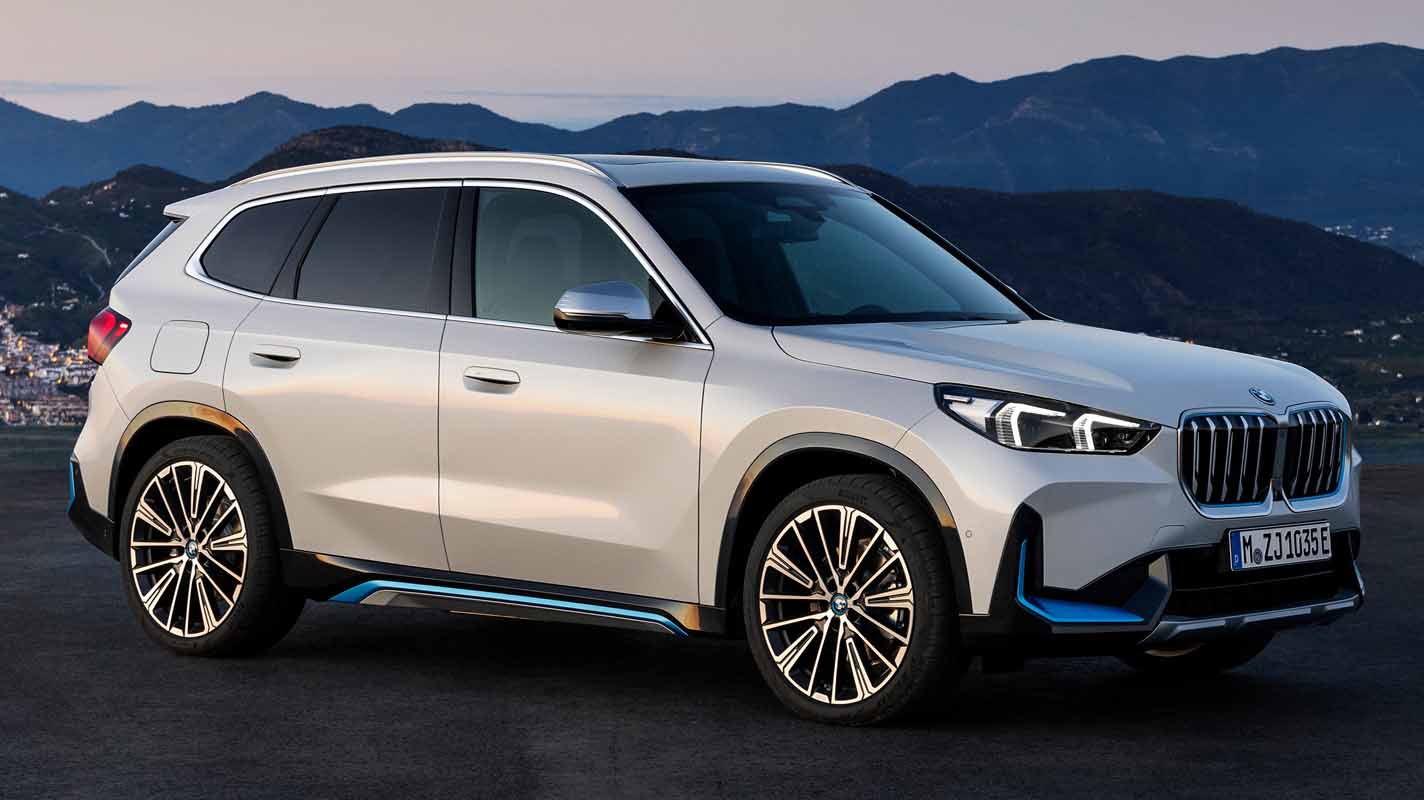
Display and control/operation system, connectivity
The new BMW X1 also treats its occupants to the latest-generation BMW iDrive multi-sensory vehicle experience in the form of the standard-fit BMW Live Cockpit Plus. Based on BMW Operating System 8 and boasting new-generation software along with exceptionally powerful connectivity and data processing, it takes the interaction between the driver and vehicle into the digital future. The new BMW iDrive system offers many more ways for drivers to enjoy easy, intuitive, multimodal control of vehicle, navigation, infotainment and communication functions and also to use digital services.
The user experience on board the new BMW X1 is underpinned by the seamless interaction between the BMW Curved Display, voice control, the multifunction buttons on the steering wheel and the optional BMW Head-Up Display. The new fully digital screen grouping and the enhanced capabilities of the BMW Intelligent Personal Assistant mean the new BMW iDrive has been deliberately geared towards interaction using touch control and natural language. As a result, operating steps carried out with the BMW Controller on the predecessor model can now be performed even more easily and intuitively using the touchscreen, voice control or the buttons on the steering wheel.
Fully digital BMW Curved Display with state-of-the-art graphics
At the heart of the display and operating system in the new BMW X1 is the standard BMW Curved Display formed by a 10.25-inch information display and a control display with a screen diagonal of 10.7 inches. The screens merge into a single unit behind a continuous glass surface that curves towards the driver.
The state-of-the-art graphics and the operating system’s menu structure have been designed with a smartphone-style appearance, making them perfect for intuitive touch control. The user interface impresses with its striking forms, dynamic light effects, strong depth of colour and modern colour worlds. Its graphical layout can be customised to suit the driving situation and personal preferences.
Welcome Scenario greets the BMW X1 driver
The engaging user experience starts before the driver has even reached the vehicle thanks to a newly devised Welcome Scenario. Ultrawideband (UWB) radio technology allows precision location pinpointing between the vehicle and the key or compatible smartphone.
Once the distance to the vehicle drops below three metres, an automated and perfectly coordinated welcome sequence commences. It starts with an orchestrated lighting effect using the exterior and interior lights, including the light carpet in the entrance area. The vehicle then automatically unlocks when the driver is about 1.5 metres away. And as they get into the car, the BMW Curved Display plays a choreographed start-up animation and shows a customised welcome window for the driver with a personal greeting as well as handy suggestions and information. In addition to this, the BMW ID settings are loaded and the smartphone connected.
Personalised driving experience with the new My Modes
The new My Modes create an all-encompassing interplay of vehicle functions, displays and interior ambience. They can be selected very easily by voice command or by using a button on the centre console that replaces the Driving Experience Control switch located there in the outgoing model. Drivers of the new BMW X1 are able to activate Personal Mode, Sport Mode and Efficient Mode as standard, with the option of also adding Expressive Mode and Relax Mode to the selection. These each activate specific settings for the powertrain and steering, the style of the readouts on the BMW Curved Display and the interior lighting.
Personal mode engages a good balance of vehicle characteristics and allows the displays and interior lighting to be adjusted to suit individual preferences. In Sport Mode, the powertrain and steering are configured for a dynamic driving style, while the pared-back readouts and red highlighting in the information display help the driver to focus on the task at hand. Efficient Mode, meanwhile, is clearly geared towards sustainable driving and configures the vehicle to keep consumption as low as possible. Here, a calming shade of blue dominates the display readouts. Striking, high-contrast colours and abstract patterns on the BMW Curved Display set the tone for the interior ambience in Expressive Mode, while in Relax Mode the focus shifts completely to well-being and relaxation, with graphics inspired by natural landscapes.
Fast, accurate, informative: the BMW Maps navigation system
The cloud-based BMW Maps navigation system included in the standard-fitted BMW Live Cockpit Plus in the new BMW X1 offers significantly enhanced performance and a high level of accuracy along with a simplified method of destination entry. The new-generation navigation system enables extremely fast route calculation, carried out dynamically and based on precise real-time traffic data transmitted at short intervals. In the BMW iX1, as soon as the destination has been entered, a charging-optimised route will be calculated if the vehicle’s current range is not enough to reach the destination. As in the BMW i7, the system now only needs a quarter of the time it used to make this calculation.
New functions for charging stops
Important additional information for the charging stops is added in the route summary, including the car’s estimated charge level upon arrival, the recommended charging time and the target charge level for the onward journey. Live data is processed during the journey, allowing new charging stations to be automatically added to the itinerary if any of the stations originally planned for charging stops no longer have availability. The driver is also now offered alternative charging-optimised routes, where available. By default, the system is set to ensure that the vehicle reaches both the final destination and the charging stops with a charge level of at least 10 per cent. Drivers can adjust the size of this charge “cushion”, if required. Charging the BMW iX1 is even easier than with the BMW i4 and BMW iX, as the authorisation and start functions for the charging process are now integrated into the My BMW App.
If the navigation system’s route guidance has planned a mid-journey stop at a DC charging point, the high-voltage battery of the BMW iX1 is pre-heated as the car approaches in order to ensure the power is taken on board as efficiently as possible. This pre-conditioning of the battery can also be initiated manually when the route guidance function is not activated.
With Connected Parking, BMW Maps is also able to provide assistance when searching for a parking space close to the final destination. Shortly before arriving, the driver is given information on the nearest multistorey car park as well as proposed routes offering a particularly good chance of finding a parking spot in the vicinity of the destination. Public charging stations in the area around the destination are also displayed in the BMW iX1 and the plug-in hybrid models.
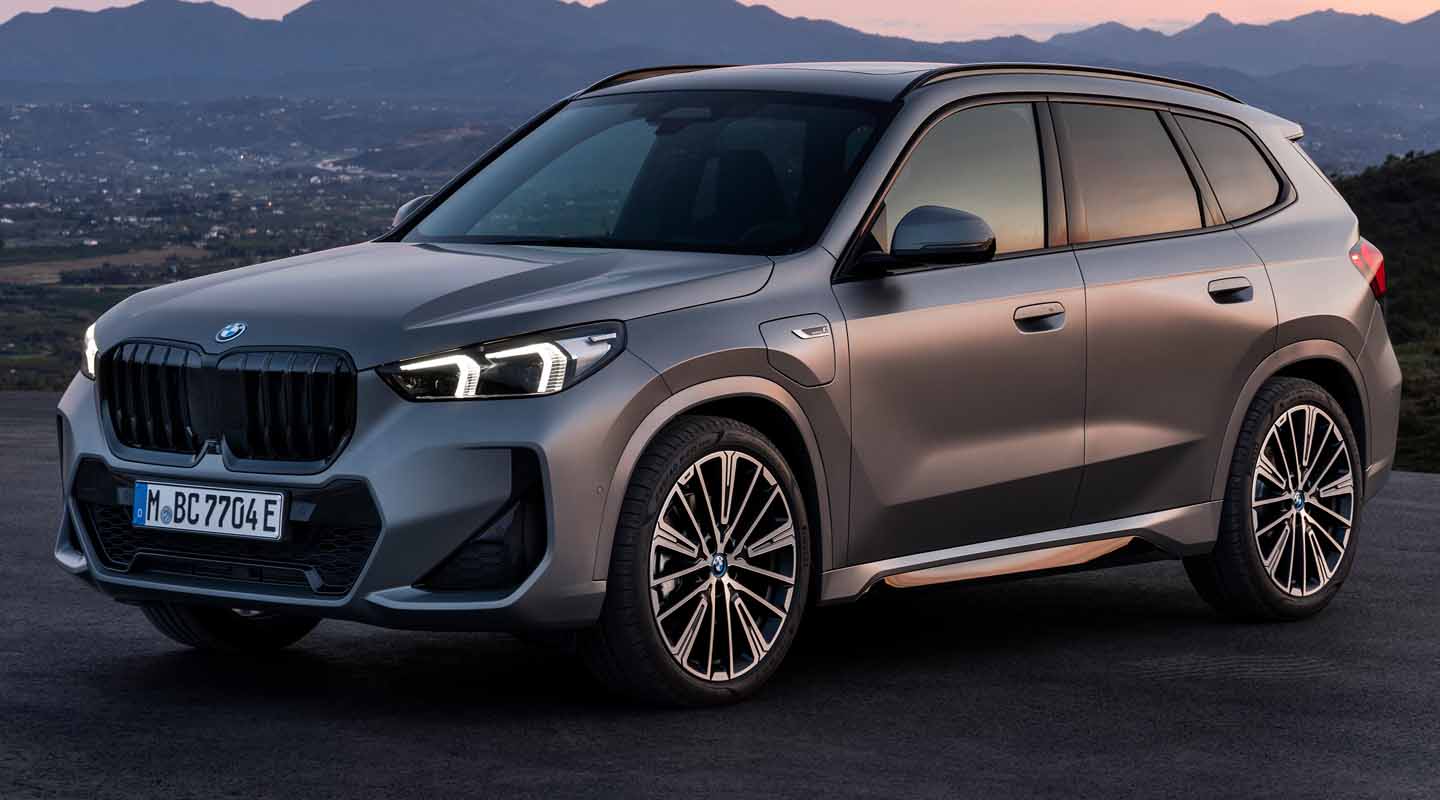
Precision navigating with Augmented View
The new Augmented View function – optionally available to supplement the navigation system’s map view – enables exceptionally accurate navigational guidance. A live video stream from the driver’s perspective is shown on the control display and augmented by supplementary information that matches the context. At confusing junctions, for instance, an animated directional arrow is integrated into the video image to help the driver take the best turn-off for the planned route.
Natural dialogue with the BMW Intelligent Personal Assistant
BMW Operating System 8 unlocks additional skills for the BMW Intelligent Personal Assistant. Naturally formulated spoken instructions can now be used to adjust the air conditioning, open a window or operate the optional panoramic glass roof, for instance. Selected functions of the driver assistance systems in the new BMW X1 can likewise be voice controlled.
When the BMW Intelligent Personal Assistant is in use, new forms of visualisation appear in the information display, the control display and the optional Head-Up Display, emphasising the system’s interactive character. The graphic appears in the right position for whoever is speaking to the assistant, thereby visualising how the system is listening attentively to what is being said. There is also a choice of two different visualisation variants.
Interior camera for snapshots and checking inside the car using the My BMW App
The new overhead interior camera can be used by the car’s occupants to take snapshots during the journey, allowing them to capture special moments and share them with friends and family.
Customers are also able to have pictures from the interior camera sent to their smartphone using the My BMW App’s remote function if they wish to glance inside the car to check whether bags or other items have been left there, for example. The interior camera is also activated when the Remote Theft Recorder is triggered.
Personalisation using the BMW ID
When customers interact with the new BMW iDrive in the new BMW X1, their user experience will be personalised to an even greater degree with the help of their BMW ID. When registering in a vehicle for the first time, simply scanning a QR code is all it takes to create a new BMW ID on a smartphone. Once BMW ID registration is complete, in vehicles with BMW Operating System 8 the newly registered BMW ID is now imported automatically into the car and the car is added automatically to the My BMW App with no further action required. If the user already has the My BMW App and therefore a BMW ID, when they register their car with the My BMW App and a QR Code scan, their existing BMW ID is imported with no further interaction if the car has BMW Operating System 7 or 8. Added to which, a car with BMW Operating System 8 now appears automatically in the My BMW App and can be viewed by up to seven users.
If the BMW ID is linked to a vehicle key, the BMW ID is uploaded when unlocking the car, and the driver is given a personal greeting on the control display. Here, the profile image they’ve set up in the My BMW App also appears. At the same time, personal settings for seat position, exterior mirrors, navigation system, driver assistance functions, display layouts, shortcuts, favourites and infotainment system settings will be loaded automatically. Personalised suggestions from the BMW Intelligent Personal Assistant, individually selected wake words and privacy settings are also stored in the BMW ID. Personal data is protected from access by other users of the vehicle by linking a key or assigning a PIN. Added to which, even more personalised settings can now be stored safely on the cloud and shared between vehicles.
Optimum connectivity with 5G and Personal eSIM
The new BMW X1 is moving into the era of 5G. If the customer selects the optional Personal eSIM, both it and the Vehicle SIM can be active simultaneously thanks to the DSDA (Dual SIM Dual Active) capability. The Personal eSIM allows the customer to use the communications and connectivity functions covered by their mobile contract from their car with ease. The vehicle is essentially turned into another digital and connected device in the customer’s ecosystem. Mobile reception for both data and phone calls is significantly improved by the vehicle’s own 5G antenna system. Up to ten devices can access the internet at any one time via the mobile hotspot.
The Personal eSIM is linked to the customer’s BMW ID rather than their car – meaning it can be transferred to other BMW vehicles with Personal eSIM functionality. The eSIM is configured automatically when users sign in with their BMW ID, after which it is available immediately.
The ability to activate the Personal eSIM is being gradually expanded in collaboration with mobile providers and network operators, and depends on the individual parameters in each country. Customers in Germany, the USA and Japan will be able to activate the Personal eSIM via participating network operators as soon as the new BMW X1 is launched. If they have a mobile contract with a different provider, they can use a Nano SIM card as an alternative to the digital SIM by inserting it into the SIM reader. Customers can find further information on the BMW website, in the My BMW App or by contacting their mobile operator.
Smartphone linking and integration of third-party services
Standard specification for the new BMW X1 also comprises optimised smartphone integration via both Apple CarPlay® and Android Auto™, allowing customers to access an array of digital services such as the voice-controlled assistant Siri, the Google Assistant, various map apps, music streaming services, and the messaging service WhatsApp.
The wireless (WiFi) connection between smartphone and vehicle enables the services to be integrated directly into the car’s display/operation system. All the key smartphone information and apps can be viewed both in the control display and – in a cleverly presented way – in the information display or optional Head-Up Display.
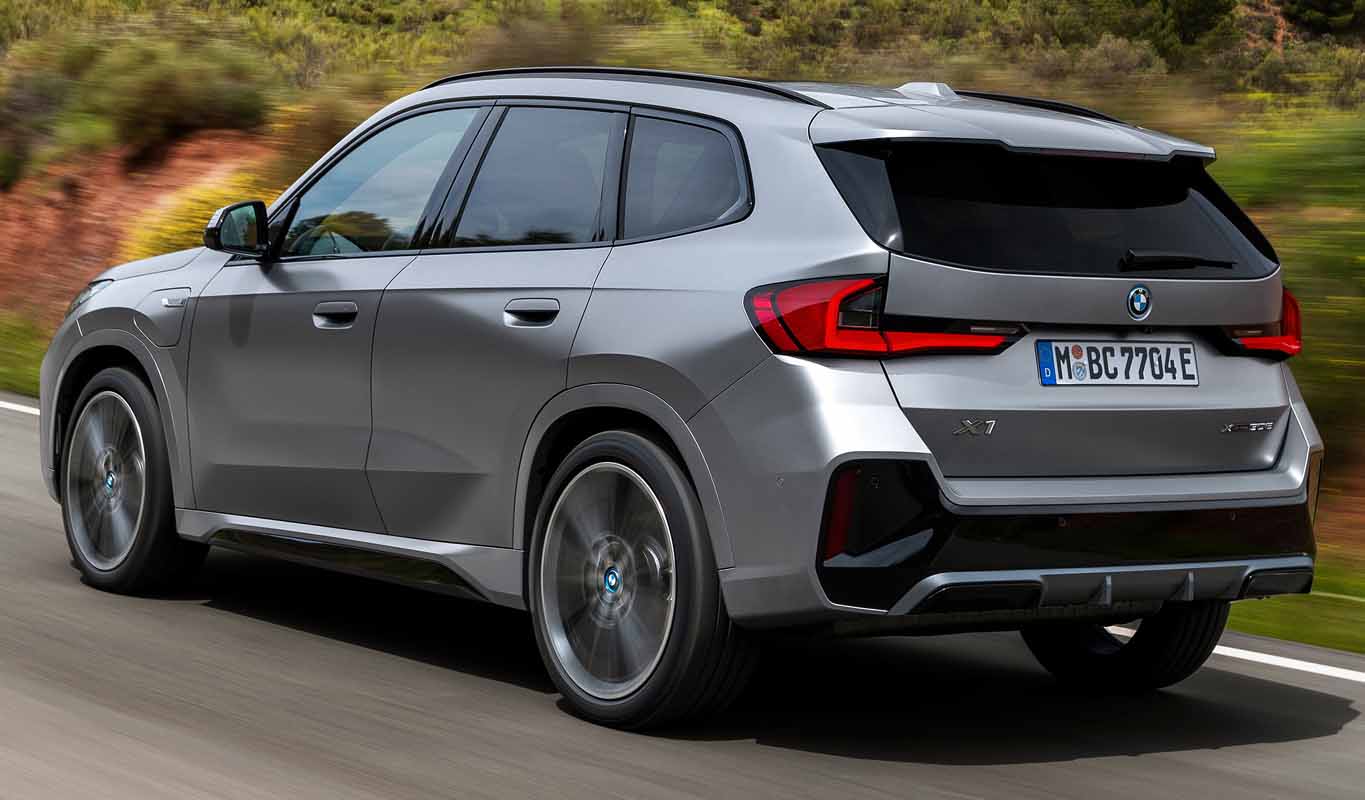
My BMW App: a universal digital interface between driver and vehicle
The My BMW App acts as a universal digital interface that provides information on the vehicle’s status at any time. And it enables remote operation of functions such as vehicle locating, locking and unlocking the doors or monitoring the car’s immediate vicinity (Remote 3D View). Features also include the ability to send destination addresses from a suitably equipped smartphone to the vehicle’s navigation system. The My BMW App additionally provides customers with a direct link to their BMW dealer and the BMW brand, allowing them to arrange service appointments, for example, or find out the latest BMW news.
Owners of a BMW iX1 or a BMW X1 plug-in hybrid are also able to remotely control charging of the high-voltage battery using the My BMW App. The preferred departure time can be entered to display the charge level the battery is expected to have reached by that point. And if the vehicle is plugged into the mains supply, charging can be started or halted at any time from the app, regardless of the charge level. Customers can also find information on the charging history in the My BMW App. The BMW Charging portfolio has now also been incorporated into the My BMW App and is neatly complemented by the app’s ability to plan charging-optimised routes. While doing this, the user is shown detailed information on the intended charging stops as well as the charging stations that will be used there.
BMW Digital Key Plus is turning into a full-function vehicle key. The optional BMW Digital Key Plus enables customers to automatically lock and unlock their new BMW X1 with their Apple iPhone when close to the vehicle by means of security-enhanced ultra-wideband (UWB) radio technology, making a conventional car key superfluous. There is no need to even remove the iPhone from their pocket as they approach the car or walk away. Once they have got in, the Apple iPhone can be simply left in the user’s pocket or placed in the smartphone tray.
The BMW Digital Key Plus can be set up using the My BMW App. The car owner can also share it – and therefore access to the vehicle – with up to five other users.
Always up to the minute: BMW ConnectedDrive Upgrades for over-the-air updates
The BMW Group is one of the key players in the field of over-the-air function upgrades. By 2020 it was carrying out the largest upgrade campaigns of any European carmaker. The BMW ConnectedDrive Upgrades function keeps the BMW X1 right up to date with the latest software. The content of the upgrades ranges from new services to improved vehicle functions.
This intelligent connectivity technology also makes it possible to incorporate additional vehicle functions that were not originally ordered – and for a limited period of time, if desired. The choice of functions available this way includes seat and steering wheel heating, Driving Assistant Plus, the Remote Engine Start function (in selected countries), the High Beam Assistant, and the Traffic Camera (in selected countries).
BMW Charging
BMW Charging paves the way for the high-voltage battery to be charged easily and flexibly at home, at the workplace or mid-journey. The BMW iX1 and the plug-in hybrid variants of the new BMW X1 already come as standard with an extensive basic spread of relevant charging solutions. Further charging products and services can be added by the customer according as they need them.
The key benefit of the BMW Charging offering for public charging stations is the attractive kilowatt-hour tariffs for AC and DC charging in Europe, which are set for each country and remain the same regardless of the charging infrastructure operator or the price shown by the charging point operator. The high-power charging network run by the BMW Group’s joint venture IONITY also forms part of the BMW Charging network. The basic monthly fee is waived for the Active tariff for the first twelve months after registering a new vehicle with BMW Charging. In addition, drivers of a BMW iX1 are also exempt from the basic fee of the IONITY Plus package for the first twelve months.
BMW iX1 and BMW X1 plug-in hybrid models in Europe are supplied with a BMW Charging Card, a charging cable (mode 3) for use at public charging stations and the Flexible Fast Charger. In addition to a thirdgeneration BMW Wallbox, other home charging products are also offered in cooperation with expert partners. These include a Smart Wallbox with extensive connectivity options enabling features such as billing in accordance with calibration law regulations and intelligent control of vehicle charging, as well as hassle-free installation of charging hardware and – if local offers allow – special green electricity tariffs.
In Europe alone, BMW Charging provides access – with a one-off registration – to more than 305,000 public charging points run by around 1,000 charging infrastructure operators. In Germany, users are able to access over 58,000 charging points operated by some 450 power suppliers. This makes BMW Charging one of the leading providers in terms of market coverage. All BMW Charging customers in Europe will be using 100 per cent green energy to charge their cars.
Sustainability in product design and manufacturing
The BMW Group is relentlessly pursuing its goal of being the most successful and also the most sustainable manufacturer of premium cars. Continuous improvements to efficiency and systematic electrification enabled the company to cut its brands’ fleet CO2 emissions by 53 per cent between 1995 and 2020. The BMW Group continued in very much the same vein in 2021, beating its CO2 emissions targets in the EU. According to its own calculations, the company undercut the target fleet value of around 126 g/km for the 27 EU countries plus Norway and Iceland by some ten grams, with WLTP fleet emissions of 115.9 grams per kilometre.
Improving sustainability is not just about drive systems with minimal or zero local emissions. Instead, consideration is given to the complete lifecycle of a vehicle, from development and procurement of raw materials through manufacturing and the use phase to subsequent recycling. The BMW Group has set itself the target of reducing carbon emissions throughout the value chain by 40 per cent by 2030. It is also the first German carmaker to have joined the Business Ambition for 1.5°C campaign led by the Science Based Targets initiative (SBTi). The company’s roadmap to climate neutrality is therefore following a scientifically validated and transparent route that is in tune with the Paris Agreement’s most ambitious objectives. At the same time, the company has also undertaken to meet the target of complete climate neutrality throughout the value chain by 2050 at the latest.
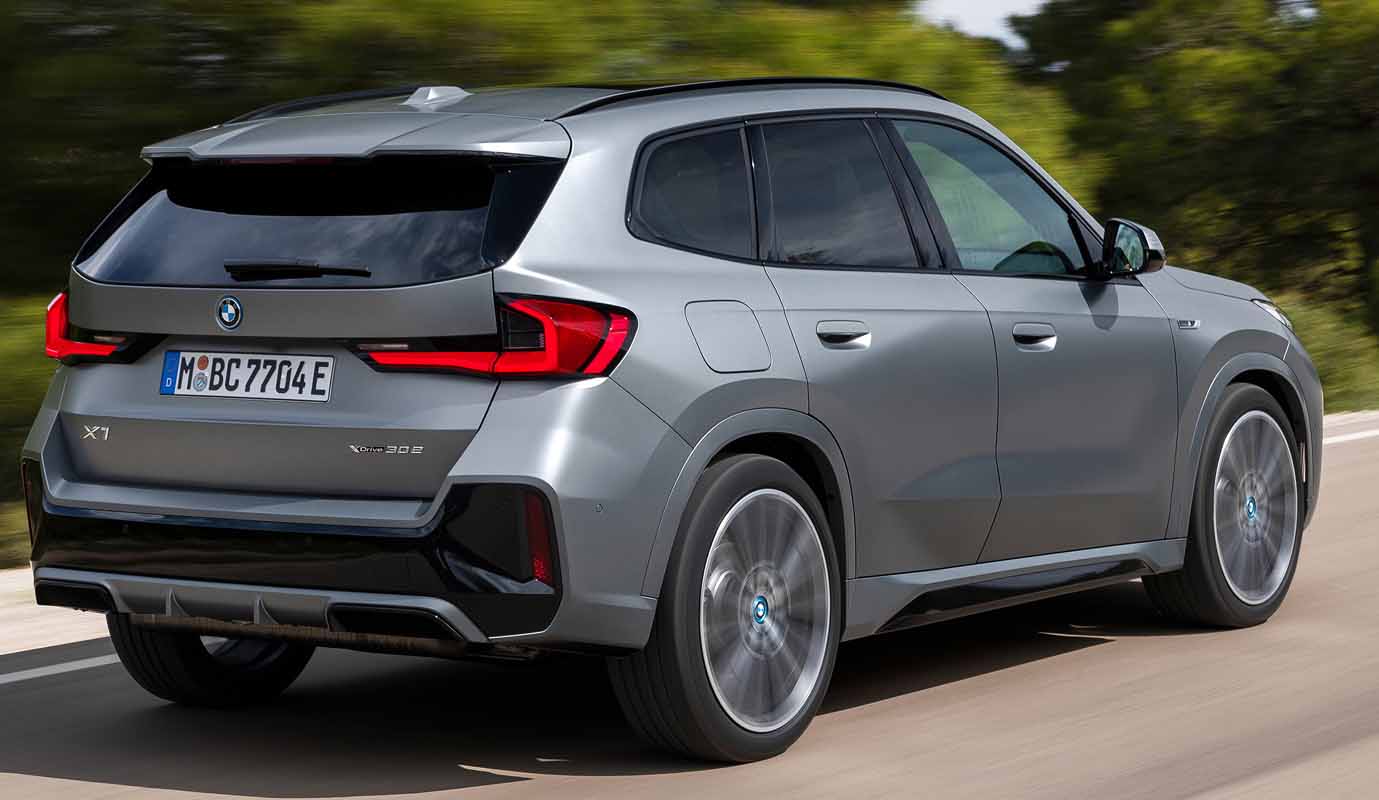
Fully electric BMW iX1 has an exemplary carbon footprint
The introduction BMW iX1 makes an extremely effective contribution to meeting BMW’s sustainability goals. The fully electric Sports Activity Vehicle for the premium compact segment opens up the experience of locally emission-free driving pleasure to broad-based target groups of customers. By offering a purely electrically powered model in this globally popular class, the BMW Group is underlining its determination to reduce the use-phase CO2 emissions of its entire fleet across all segments by another 50 per cent by 2030 compared to the figure for 2019.
The global warming potential of the new BMW iX1 xDrive30 throughout its lifecycle is around 30 per cent lower than that of the new BMW X1 sDrive18i with combustion engine when using the current EU electricity mix. If renewable power is used for charging, its lifecycle global warming potential is around 60 per cent lower than that of the BMW X1 sDrive18i with combustion engine. The carbon footprint for the new BMW iX1 will be stated in a validation certificate endorsed by independent auditors by the time production starts in July 2022.
A particularly rigorous approach is taken to reducing the CO2 emissions released during production of the fifth-generation BMW eDrive technology employed in the new BMW iX1 and the plug-in hybrid variants of the new BMW X1. In the supply chain alone, utilising green electricity for battery cell production and making increased use of secondary raw materials cuts CO2 emissions by around 20 per cent compared with a vehicle where these measures are not deployed.
Fifth-generation BMW eDrive technology also sets new standards in terms of efficiency and conserving resources. The design principle for the electric motors enables the use of rare-earth metals to be avoided, meaning that the BMW Group is not dependent on the availability of these critical raw materials. In addition, the BMW Group purchases the cobalt and lithium required for the high-voltage batteries itself and then supplies it to the firms who make the battery cells. The company can therefore ensure that environmental and sustainability standards are observed during the extraction and processing of cobalt and lithium and that there are no violations of human rights.
Sustainability throughout the value cycle
The selection of materials was carefully thought out and clearly defined in the early phase of the series development process. This optimises the sustainability of the product substance and the production processes for all variants of the new BMW X1 and ensures a high degree of recyclability at the end of its lifecycle. The BMW Group’s high sustainability standards also comprise a commitment to reducing the quantities of CO2 emitted during production and apply throughout the value cycle, including the supply chain.
The BMW Group has undertaken to create the most sustainable supply chain anywhere in the automotive industry. The focal points on the purchasing side are compliance with environmental and social standards, respect for human rights, conservation of natural resources and reduction of CO2 emissions. Measures for optimising sustainability are therefore established in consultation with suppliers, such as using secondary raw materials and harnessing renewable energy.
Use of secondary materials and renewable raw materials
Among other sustainability goals set out by the BMW Group is the increased use of secondary raw materials in vehicle production. The company is pursuing the vision of a circular economy with the aim of keeping raw materials within a loop for as long as possible, thereby reducing the input of primary materials as well as the associated potentially environmentally harmful mining of raw materials and their often energy- and carbon-intensive processing. At present, vehicles are manufactured using nearly 30 per cent recycled and reused material on average. The ‘secondary first’ approach is intended to gradually increase this figure to 50 per cent.
To reduce the input of primary aluminium, which leads to a particularly energy-intensive manufacturing process, the BMW Group has decided to make targeted use of secondary material for this high-grade lightweight metal. The proportion of secondary aluminium used in manufacturing the castings for the models in the new BMW X1 is already up to as much as 70 per cent. In order to drive forward efforts to consistently increase the proportion of secondary raw materials used, the bonnet of the new BMW X1 – like other aluminium components – can be completely removed and is therefore suitable for high-quality recycling.
The proportion of secondary raw materials used in the sheet steel for the body of the new BMW X1 has also been increased thanks to new manufacturing technologies such as electric arc techniques. Plus, at the end of the SAV’s life, its 100-per cent steel welded body structure can be fully recycled into sheet steel that can then be reused in automotive construction.
Using secondary materials instead of primary materials brings about a substantial reduction in CO2 emissions of around 80 per cent for aluminium and up to 70 per cent for steel (depending on the exact alloy/material composition). Utilizing secondary materials has the additional benefits of preserving natural resources and helping to prevent infringement of environmental and social standards along the entire supply chain.
The BMW Group has created closed loops for steel and aluminium between the plants responsible for the new BMW X1 in Regensburg and Landshut as well as its suppliers. All steel waste from the BMW Group’s press shops is supplied to steel companies and reused. Aluminium waste from the Dingolfing and Munich plants is likewise sent to aluminium companies, with some 70 per cent of the residual material eventually being reused as part of a direct closed-loop system.
In addition, high-quality recycled plastics are used for many components in the new BMW X1. In order to increase the recyclability of production residues and components at the end of use, around 20 per cent of the plastic parts are made from mono-material. These include underbody panelling, wheel arch covers, mounting elements for trim parts and a host of unlaminated trim elements in the interior. This unmixed production waste and components can generally be mechanically processed into high-quality recycled material. The floor mats of the new BMW X1 are 100 per cent polyester, which of 55 per cent recycled material. The aim is to gradually increase this figure to 100 per cent as we go forward.
A large number of soundproofing elements are made of a mixed fibre fabric created from recycled textile waste. The floor coverings inside the new BMW X1 feature a synthetic yarn that is produced from recycled nylon waste material. The sources used for this material, which is known by the name of Econyl, include fishing nets recovered from the sea along with worn flooring and residual waste from plastics manufacturing. Using this material helps to both preserve resources and reduce climatedamaging emissions. The process for manufacturing the recycled plastic emits around 80 per cent less CO2 than conventional production of petroleum-based nylon.
Electricity from renewable resources for component and vehicle manufacture
CO2 emissions from vehicle production have been lowered by over 70 per cent since 2006. All plants in the BMW Group’s international production network have been operating a net carbon-neutral policy since 2021.
Electricity from renewable sources represents one of the most important levers for cutting CO2 emissions in the supply chain too. The BMW Group has signed over 400 contracts with suppliers agreeing the use of green power, encompassing not just manufacturers of battery cells for the fifthgeneration BMW eDrive technology, but also aluminium suppliers and manufacturers of aluminium components. Since February 2021, the BMW Group has been procuring aluminium manufactured in the United Arab Emirates with the help of solar power. Electricity generated in a vast solar park located in the desert outside Dubai is used for producing the lightweight metal. The quantity of aluminium acquired that has been produced using solar power covers nearly half the annual requirements of the light metal foundry at BMW Group Plant Landshut, whose output includes the casings for the latest-generation electric motors fitted in the BMW iX1.
Starting in 2024, the new BMW X1 will also benefit from the switch to cast aluminium wheels manufactured entirely using green electricity. This will see the BMW Group take another step towards its target of establishing the most sustainable supply chain in the entire automotive industry. The switch will apply to both the extremely energy-intensive electrolysis stage during aluminium manufacture and the process of casting the wheels. The necessary agreements for this have been reached with all the BMW Group’s wheel suppliers.
Wheels have hitherto accounted for some five per cent of the CO2 emissions produced in the supply chain. This figure will be more than halved by the switch to more sustainable production using green electricity. The BMW Group is supplied with around 10 million light-alloy wheels every year, 95 per cent of which are cast aluminium wheels. The company will be able to ensure that the aluminium material is handled in a conscious and sustainable way by the contracted manufacturers by conducting independent inspections and will save as much as 500,000 tonnes of CO2 per year.
Sustainable production at BMW Group Plant Regensburg
All the model variants of the new BMW X1 will be built at BMW Group Plant Regensburg. Vehicles with fully electric drive, plug-in hybrid systems and combustion engines will roll off the same assembly line for the first time at this location.
The Regensburg plant already gained experience and developed expertise in the field of electric mobility through production of the plug-in hybrid variant of the outgoing BMW X1. In April 2021, the plant also began production of electric drive components with the first of four coating units for battery cells. Coating increases the battery cell’s mechanical robustness and thermal conductivity. This helps improve insulation and cooling of the battery cells for the fifth-generation BMW eDrive technology. With the start of production of the new BMW iX1, high-voltage batteries for this model will also be produced from battery modules at BMW Group Plant Regensburg. By the end of 2022, the number of employees working in battery component production at the plant will rise to more than 300. Between 2020 and 2022, the BMW Group invested more than 150 million euros in ramping up production of battery components and high-voltage batteries in Regensburg.
Systematic reduction of CO2 in the use phase
All variants of the new BMW X1 come with the latest generation of the all-electric, plug-in hybrid or combustion-engined drive system that powers them. They have been developed as part of an open-ended innovation process underpinned by BMW Efficient Dynamics which aims to make personal mobility more sustainable. The new BMW iX1 comes with an upgraded version of adaptive recuperation for increased efficiency and range. When combined with an anticipatory style of driving, this adaptive recuperation function allows more than 90 per cent of all deceleration to be performed using brake energy regeneration alone, without any need to trouble the braking system. Optimised control of the high-voltage battery’s temperature prolongs its service life. BMW Charging customers across Europe are able to replenish the high-voltage battery purely with carbon-neutral energy from all power suppliers.
The new plug-in hybrid model variants boast a much longer electric range than the outgoing generation. The standard BMW eDrive Zone function can automatically trigger the switch to the pure-electric driving mode when entering city centres, thereby making the most of the plug-in hybrid drive’s potential for providing locally emission-free mobility. The BMW eDrive Zone function is already available in 138 European cities, where vehicles can recognise the designated zones with the help of geofencing technology and GPS. Associated with this is a bonus system unique worldwide. Here, drivers of BMW plug-in hybrid models earn points for every all-electric mile they clock up, with double points awarded in eDrive Zones. These points can then be redeemed against electricity for charging the car.
All other models feature petrol and diesel units from the new BMW Group Efficient Dynamics engine family. With the exception of the extremely efficient entry-level units, all the petrol and diesel engines for the new BMW X1 are combined with the latest 48V mild hybrid technology. This has the effect of compensating for the additional fuel consumption caused by the car’s far more extensive standard specification, and actually more than cancels out the difference on some model variants. This is further helped by the intelligent lightweight design measures for the body and chassis of the new BMW 7-Series as well as its optimised aerodynamic properties. The flush-fitting door handles and aerodynamically optimised light-alloy wheels are two of the new features that serve to streamline airflow.
Digital technology is also used to boost efficiency on all model variants. The new Efficiency Trainer keeps the driver permanently informed of the driving state and energy flow as well as encouraging them to drive in the most efficient way possible. At the same time, the new My Modes provide a complete efficiency experience. The driver receives advice on throttle control for the situation at hand in both the information display and the optional BMW Head-Up Display. A power meter displays tips for accelerating, decelerating or driving at a constant speed efficiently. In the process, camera and navigation system data is also used to assist with anticipatory driving when approaching a junction, a built-up area or a change of speed limit. The driving style analysis provides an evaluation of acceleration behaviour and anticipatory use of the accelerator. The reward for efficiency-optimised driving is extra range.
